Culture of the United States
| This article is part of a series on the |
| Culture of the United States |
|---|
 |
| Society |
| Arts and literature |
| Other |
| Symbols |
|
United States portal |
Theculture of the United Statesencompasses varioussocial behaviors,institutions, andnormsin theUnited States,including forms ofspeech,literature,music,visual arts,performing arts,food,sports,religion,law,technologyas well as other customs, beliefs, and forms of knowledge. American culture has been shaped by thehistory of the United States,its geography,and various internal and external forces and migrations.[1]
America's foundations were initiallyWestern-based, and primarilyEnglish-influenced,but also with prominentFrench,German,Greek,Irish,Italian,Jewish,Polish,Scandinavian,andSpanishregional influences. However, non-Western influences, includingAfricanandIndigenouscultures, and more recently,Asian cultures,have firmly established themselves in the fabric of American culture as well. Since the United States wasestablishedin 1776, its culture has been influenced by successive waves ofimmigrants,and the resulting "melting pot"of cultures has been a distinguishing feature ofits society.Americans pioneeredor made great strides in musicalgenressuch asheavy metal,rhythm and blues,jazz,gospel,country,hip hop,androck 'n' roll.The "big four sports"areAmerican football,baseball,basketball,andice hockey.Interms of religion,the majority of Americans areProtestantorCatholic.Theirreligiouselement is growing.American cuisineincludes popular tastes such ashot dogs,milkshakes,andbarbecue,as wellas many other class and regional preferences.The most commonly used language is English, though the United States does not have an official language.[2]Distinctcultural regionsincludeNew England,Mid-Atlantic,theSouth,Midwest,Southwest,Mountain West,andPacific Northwest.[3]
Politically, the country takes its values from theAmerican RevolutionandAmerican Enlightenment,with an emphasis onliberty,individualism,andlimited government,as well as theBill of RightsandReconstruction Amendments.Under theFirst Amendment,the United States has thestrongest protections of free speech of any country.[4][5][6][7]American popular opinion is also the most supportive offree expressionand theright to use the Internet.[8][9]The large majority of the United States has a legal system that is based uponEnglish common law.[10]According to theInglehart–Welzel cultural map,it leans greatly towards "self-expression values",while also uniquely blending aspects of" secular-rational "(with a strong emphasis onhuman rights,the individual,andanti-authoritarianism) and "traditional" (with highfertility rates,religiosity,andpatriotism) values together.[11][12][13]Its culture can vary by factors such asregion,race and ethnicity,age, religion,socio-economic status,orpopulation density,among others. Different aspects of American culture can be thought of aslow cultureorhigh culture,or belonging to any of a variety ofsubcultures.The United States exerts major cultural influenceon a global scaleand is considered acultural superpower.[14][15]
History
Origins, development, and spread

The European roots of the United States originate with theEnglishandSpanishsettlers ofcolonial North AmericaduringBritishandSpanish rule.The varieties of English people, as opposed to the other peoples on the British Isles, were the overwhelming majority ethnic group in the 17th century (the population of the colonies in 1700 was 250,000) and were 47.9% of percent of the total population of 3.9 million. They constituted 60% of the whites at the first census in 1790 (%: 3.5 Welsh, 8.5Scotch Irish,4.3 Scots, 4.7 Irish, 7.2 German, 2.7 Dutch, 1.7 French, and 2 Swedish).[16][citation needed]The English ethnic group contributed to the major cultural and social mindset and attitudes that evolved into the American character. Of the total population in each colony, they numbered from 30% in Pennsylvania to 85% in Massachusetts.[17]Large non-English immigrant populations from the 1720s to 1775, such as the Germans (100,000 or more), Scotch Irish (250,000), added enriched and modified the English cultural substrate.[18]The religious outlook was some versions of Protestantism (1.6% of the population comprised English, German, and Irish Catholics).[citation needed]
Jeffersonian democracywas a foundational American cultural innovation, which is still a core part of the country's identity.[19]Thomas Jefferson'sNotes on the State of Virginiawas perhaps the first influential domestic cultural critique by an American and was written in reaction to the views of some influential Europeans that America's native flora and fauna (including humans) weredegenerate.[19]

Major cultural influences have been brought by historical immigration, especially fromGermanyin much of the country,[20]Ireland and Italy in theNortheast,and Japan inHawaii.Latin American cultureis especially pronounced in former Spanish areas but has also been introduced by immigration, as haveAsian American cultures(especially in the Northeast and West Coast regions).Caribbeanculture has been increasingly introduced by immigration and is pronounced in many urban areas. Since the abolition of slavery, the Caribbean has been the source of the earliest and largest Black immigrant group, a significant source of growth of the Black population in the U.S. and has made major cultural impacts in education, music, sports and entertainment.[21]
Native culture remains strong in areas with large undisturbed or relocated populations, including traditional government and communal organization of property now legally managed byIndian reservations(large reservations are mostly in the West, especiallyArizonaandSouth Dakota). The fate of native culture after contact with Europeans is quite varied. For example,Taínoculture in U.S. Caribbean territories is nearly extinct and like most Native American languages, theTaíno languageis no longer spoken. By contrast, theHawaiian languageandculture of the Native Hawaiianshas survived in Hawaii and mixed with that of immigrants from the mainland U.S. (starting before the1898 annexation) and to some degree Japanese immigrants. It occasionally influences mainstream American culture with notable exports likesurfingandHawaiian shirts.Most languages native to what is now U.S. territory have gone extinct,[22]and the economic and mainstream cultural dominance of the English language threatens the surviving ones in most places. Some of the most common native languages includeSamoan,Hawaiian,Navajo,Cherokee,Sioux,and a spectrum ofInuit languages.(SeeIndigenous languages of the Americasfor a fuller listing, plusChamorro,andCarolinianin the Pacific territories.)[23][better source needed]Ethnic Samoansare a majority inAmerican Samoa;Chamorroare still the largest ethnic group inGuam(though a minority), and along withRefaluwaschare smaller minorities in theNorthern Mariana Islands.[citation needed]

American culture includes both conservative and liberal elements, scientific and religious competitiveness, political structures, risk taking and free expression, materialist and moral elements. Despite certain consistent ideological principles (e.g.individualism,egalitarianism,and faith infreedomandrepublicanism), American culture has a variety of expressions due to its geographical scale and demographics.[24]
As amelting potof cultures andethnicities,the U.S. has been shaped by the world'slargestimmigrant population.The country is home to awide varietyof ethnic groups, traditions, and values,[25][26]and exerts major cultural influence on a global scale, with the phenomenon being termedAmericanization.[27][28][14][15]
Regional variations


Semi-distinct culturalregions of the United StatesincludeNew England,theMid-Atlantic,theSouth,theMidwest,theSouthwest,and theWest—an area that can be further subdivided into thePacific Statesand theMountain States.[citation needed]
According to cultural geographer Colin Woodward there are as many as eleven cultural areas of the United States, which spring from their settlement history. In the east, from north to south: there are Puritan areas ( "Yankeedom" ) of New England which spread across the northern Great Lakes to the northern reaches of theMississippiandMissouri Rivers;theNew Netherlandsarea in the densely populatedNew York metropolitan area;the Midland area which spread fromPennsylvaniato the lowerGreat Lakesand the trans-Mississippi upper midwest; GreaterAppalachiawhich angles from West Virginia through the lower midwest and upper-south to trans-Mississippi Arkansas, and southern Oklahoma; the Deep South from the Carolinas to Florida and west to Texas. In the west, there is the southwestern "El Norte" areas originally colonized by Spain, the "Left Coast" colonized quickly on the 19th century by a mix of Yankees and upper Appalachians, and the large but sparsely populated interior West.[29][30]
Thewest coastof the continental United States, consisting of California,Oregon,andWashingtonstate, is also sometimes referred to as theLeft Coast,indicating itsleft-leaning political orientationand tendency towardssocial liberalism.[citation needed]
TheSouthis sometimes informally called the "Bible Belt"due tosocially conservativeevangelicalProtestantism,which is a significant part of the region's culture. Christianchurch attendanceacross all denominations is generally higher there than the national average. This region is usually contrasted with themainline ProtestantismandCatholicismof theNortheast,the religiously diverseMidwestandGreat Lakes,theMormon CorridorinUtahand southernIdaho,and therelatively secularWest.The percentage ofnon-religiouspeople is the highest in thenortheasternand New England state ofVermontat 34%, compared to 6% in the Bible Belt state ofAlabama.[31]
Strong cultural differences have a long history in the U.S., with the southern slave society in the antebellum period serving as a prime example. Social and economic tensions between the Northern and Southern states were so severe that they eventually caused the South to declare itself an independent nation, theConfederate States of America;thus initiating theAmerican Civil War.[32]
Cultures of regions in the United States
- Culture of New England
- Culture of the Southern United States
- Culture of the Midwest
- Culture of Western United States
- Appalachian Culture
Language

Although the United States has noofficial languageat the federal level,28 stateshave passed legislation making English the official language, and it is considered to be thede factonational language. According to the2000 U.S. Census,more than 97% of Americans can speak English well, and for 81%, it is the only language spoken at home. The national dialect is known asAmerican English,which itself consists of numerous regional dialects, but has some sharedunifying features that distinguish it from British Englishand other varieties of English. There are four largedialect regionsin the United States—theNorth,theMidland,theSouth,and theWest—and several dialects more focused withinmetropolitan areassuch as those ofNew York City,Philadelphia,andBoston.Astandard dialectcalled "General American"(analogous in some respects to thereceived pronunciationelsewhere in theEnglish-speaking world), lacking the distinctive noticeable features of any particular region, is believed by some to exist as well; it is sometimes regionally associated with the Midwest.American Sign Language,used mainly by the deaf, is also native to the United States.[citation needed]
More than 300 languages nationwide, and up to 800 languages inNew York City,besides English, have native speakers in the United States—some are spoken byindigenous peoples(about 150living languages) and others imported by immigrants. English is not the first language of most immigrants in the US, though many do arrive knowing how to speak it, especially from countries where English is broadly used.[33]This not only includes immigrants from countries such asCanada,Jamaica,and theUK,where English is the primary language, but also countries where English is an official language, such asIndia,Nigeria,and thePhilippines.[33]
According to the 2000 census, there were nearly 30 million native speakers ofSpanish in the United States.Spanish has official status in theCommonwealth of Puerto Rico,where it is the primary language spoken, and the state ofNew Mexico;numerous Spanish enclaves exist around the country as well.[34]Bilingual speakers may use both English and Spanish reasonably well and maycode-switchaccording to their dialog partner or context, a phenomenon known asSpanglish.[citation needed]
Indigenous languages of the United States include theNative-American languages(includingNavajo,Yupik,Dakota,andApache), which are spoken on the country's numerousIndian reservationsand at cultural events such aspow wows;Hawaiian,which has official status in the state of Hawaii;Chamorro,which has official status in the commonwealths ofGuamand theNorthern Mariana Islands;Carolinian,which has official status in the commonwealth of theNorthern Mariana Islands;andSamoan,which has official status in the commonwealth ofAmerican Samoa.
| Language | Percentage of the total population |
|---|---|
| English only | 78.2% |
| Spanish | 13.4% |
| Chinese | 1.1% |
| Other | 7.3% |
Customs and traditions
Cuisine
The cuisine of the United States is extremely diverse, owing to the vastness of the country, the relatively large population (1⁄3of a billion people) and the significant number of native and immigrant influences. Mainstream American culinary arts are similar to those in other Western countries. Wheat and corn are the primarycereal grains.[citation needed]Traditional American cuisine uses ingredients such asturkey,potatoes,sweet potatoes,corn(maize),squash,andmaple syrup,as well as indigenous foods employed by American Indians and early European settlers, African slaves, and their descendants.[citation needed]
Iconic American dishes such asapple pie,donuts,fried chicken,pizza,hamburgers,andhot dogsderive from the recipes of various immigrants and domestic innovations.[36][37]French fries,Mexican dishes such asburritosandtacos,and pasta dishes freely adapted from Italian sources are consumed.[38]
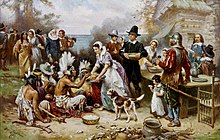
The types of food served at home vary greatly and depend upon the region of the country and the family's own cultural heritage. Recent immigrants tend to eat food similar to that of their country of origin, andAmericanizedversions of these cultural foods, such asChinese American cuisineorItalian American cuisineoften eventually appear.Vietnamese cuisine,Korean cuisine,andThai cuisinein authentic forms are often readily available in large cities.German cuisinehas a profound impact on American cuisine, especially Midwestern cuisine; potatoes, noodles, roasts, stews, cakes, and other pastries are the most iconic ingredients in both cuisines.[39]Dishes such as the hamburger, pot roast, baked ham, and hot dogs are examples of American dishes derived from German cuisine.[40][41]
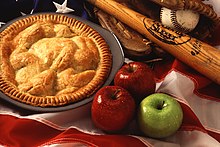
Different regions of the United States have their own cuisine and styles of cooking. The states of Louisiana and Mississippi, for example, are known for theirCajunandCreole cooking.Cajun and Creole cooking are influenced by French, Acadian, and Haitian cooking, although the dishes themselves are original and unique. Examples includeCrawfish Étouffée,Red beans and rice,seafood or chickengumbo,jambalaya,andboudin.Italian, German, Hungarian, and Chinese influences, traditional Native American, Caribbean, Mexican, and Greek dishes have also diffused into the general American repertoire. It is not uncommon for amiddle-classfamily fromMiddle Americato eat, for example, restaurant pizza, home-made pizza, enchiladas con carne,chicken paprikash,beef stroganoff,andbratwurstwithsauerkrautfor dinner throughout a single week.[citation needed]
Soul food,mostly the same as food eaten by white southerners, developed by southern African slaves, and their free descendants, is popular around the South and among manyAfrican Americanselsewhere.Syncreticcuisines such as Louisiana Creole, Cajun,Pennsylvania Dutch,andTex-Mexare regionally important.
Americans generally prefer coffee over tea, and more than half the adult population drinks at least one cup of coffee per day.[42]Marketing by U.S. industries is largely responsible for makingorange juiceandmilk(now often fat-reduced) ubiquitous breakfast beverages.[43]During the 1980s and 1990s, thecaloric intakeof Americans rose by 24%;[38]and frequent dining at fast food outlets is associated with what health officials call theAmerican"obesity epidemic."Highly sweetenedsoft drinksare popular; sugared beverages account for 9% of the average American's daily caloric intake.[44]
The Americanfast foodindustry, the world's first and largest, is also often viewed as being a symbol of U.S. marketing dominance. Companies such asMcDonald's,[45]Burger King,Pizza Hut,Kentucky Fried Chicken,andDomino's Pizzaamong others, have numerous outlets around the world,[46]and pioneered thedrive-throughformat in the 1940s.[47]
- Some representative American foods
-
TraditionalThanksgiving dinnerwith turkey, dressing, sweet potatoes, and cranberry sauce
-
A cream-based New Englandchowder,traditionally made with clams and potatoes
-
Fried chicken,a southern dish consisting of chicken pieces that have been coated with seasoned flour or batter and deep fried
-
CreoleJambalayawith shrimp, ham, tomato, and Andouille sausage
-
Chicken-fried steak(or Country Fried Steak)
-
Asubmarine sandwich,which includes a variety of Italian luncheon meats
-
American style breakfastwith pancakes, maple syrup,sausage links,bacon strips, and fried eggs
-
Ahot dogsausage topped with beef chili, white onions and mustard
-
Anapple cobblerdessert
Sports
In the 1800s, colleges were encouraged to focus on intramural sports, particularlytrack and field,and, in the late 1800s, American football. Physical education was incorporated into primary school curriculums in the 20th century.[48]
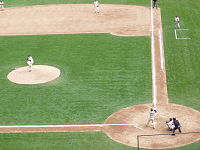
Baseballis the oldest of the major American team sports. Professional baseball dates from 1869 and had no close rivals in popularity until the 1960s. Though baseball is no longer the most popular sport,[49]it is still referred to as "thenational pastime."Also unlike the professional levels of the other popular spectator sports in the U.S.,Major League Baseballteams play almost every day. The Major League Baseballregular seasonconsists of each of the 30 teams playing 162 games from late March to early October. The season ends with thepostseasonandWorld Seriesin October. Unlike most other major sports in the country, professional baseball draws most of its players from a"minor league"system, rather than fromuniversity athletics.
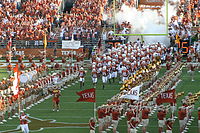
American football,known in the United States as simply "football", now attracts more television viewers than any other sport and is considered to be the most popular sport in the United States.[50]The 32-teamNational Football League(NFL) is the most popular professional American football league. TheNational Football Leaguediffers from the other threemajor pro sports leaguesin that each of its 32 teams plays one game a week over 18 weeks, for a total of 17 games with onebyeweek for each team. TheNFL seasonlasts from September to December, ending with theplayoffsandSuper Bowlin January and February. Its championship game, theSuper Bowl,has often been the highest rated television show, and it has an audience of over 100 million viewers annually.[citation needed]
College footballalso attracts audiences of millions. Some communities, particularly in rural areas, place great emphasis on their localhigh school footballteam. American football games usually includecheerleadersandmarching bands,which aim to raise school spirit and entertain the crowd athalftime.
Basketballis another major sport, represented professionally by theNational Basketball Association.It was invented inSpringfield, Massachusetts,in 1891, by Canadian-born physical education teacherJames Naismith.College basketballis also popular, due in large part to theNCAA men's Division I basketball tournamentin March, colloquially known as "March Madness".
Ice hockeyis the fourth-leading professional team sport. Always a mainstay ofGreat LakesandNew England-area culture, the sport gained tenuous footholds in regions like theAmerican Southsince the early 1990s, as theNational Hockey Leaguepursued a policy of expansion.[51]

Lacrosseis a team sport ofAmericanandCanadianNative Americanorigin and is most popular on the East Coast.NLLandMLLare the nationalboxandoutdoor lacrosseleagues. Many of the top Division I college lacrosse teams draw upwards of 7–10,000 for a game, especially in theMid-AtlanticandNew Englandareas.
Socceris very popular as a participation sport, particularly among youth, and theUS national teamsare competitive internationally. A twenty-six-team (with four more confirmed to be added within the next few years) professional league,Major League Soccer,plays from March to October, but its television audience and overall popularity lag behind other American professional sports.[53]
Other popular sports aretennis,softball,rodeo,swimming,water polo,fencing,shooting sports,hunting,volleyball,skiing,snowboarding,skateboarding,ultimate,disc golf,cycling,MMA,roller derby,wrestling,weightlifting,andrugby.

Relative to other parts of the world, the United States is unusually competitive in women's sports, a fact usually attributed to theTitle IXanti-discrimination law, which requires most American colleges to give equal funding to men's and women's sports.[54]Despite that, however, women's sports are not nearly as popular among spectators as men's sports.
The United States enjoys a great deal of success both in theSummer OlympicsandWinter Olympics,constantly finishing among the top medal winners.
Sports and community culture
Homecomingis an annual tradition in the United States. People, towns, high schools and colleges come together, usually in late September or early October, to welcome back former residents andalumni.It is built around a central event, such as abanquet,aparade,and most often, a game ofAmerican football,or, on occasion,basketball,wrestlingorice hockey.When celebrated by schools, the activities vary. However, they usually consist of a football game, played on the school's home football field, activities for students and alumni, aparadefeaturing the school'smarching bandand sports teams, and the coronation of aHomecoming Queen.
American high schools commonly field football, basketball, baseball, softball, volleyball, soccer, golf, swimming, track and field, and cross-country teams as well.
Public holidays


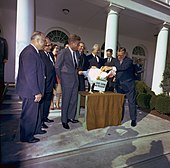
The United States observes holidays derived from events inAmerican history,Christian traditions,andnational patriarchs.
Thanksgivingis the principal traditionally-American holiday, evolving from the EnglishPilgrim'scustom of giving thanks for one's welfare. Thanksgiving is generally celebrated as a family reunion with a large afternoon feast.Independence Day(or the Fourth of July) celebrates the anniversary of the country'sDeclaration of Independencefrom Great Britain, and is generally observed by parades throughout the day and the shooting of fireworks at night.
Christmas Day,celebrating the birth ofJesus Christ,is widely celebrated and a federal holiday, though a fair amount of its current cultural importance is due to secular reasons.European colonizationhas led to some otherChristian holidayssuch asEasterandSt. Patrick's Dayto be observed, though with varying degrees of religious fidelity.
Halloweenis thought to have evolved from the ancient Celtic/Gaelic festival ofSamhain,which was introduced in the American colonies by Irish settlers. It has become a holiday that is celebrated by children and teens who traditionally dress up in costumes and go door to door trick-or-treating for candy. It also brings about an emphasis on eerie and frighteningurban legendsand movies.Mardi Gras,which evolved from the Catholic tradition ofCarnival,is observed in the state ofLouisiana.
| Date | Official name | Remarks |
|---|---|---|
| January 1 | New Year's Day | Celebrates beginning of theGregorian calendaryear. Festivities include counting down to midnight (12:00 am) on a preceding night, New Year's Eve. The traditional end of the holiday season. |
| Third Monday of January | Birthday of Martin Luther King Jr., orMartin Luther King Jr. Day | HonorsMartin Luther King Jr.,Civil Rightsleader, who was actually born on January 15, 1929; combined with other holidays in several states. |
| Third Monday of February | Washington's Birthday | Washington's Birthday was first declared a federal holiday by an 1879 act of Congress.The Uniform Holidays Act,1968, shifted the date of the commemoration of Washington's Birthday from February 22 to the third Monday in February. Though its formal name was never changed, many call it "Presidents' Day"and consider it a day honoring all American presidents.[56] |
| Last Monday of May | Memorial Day | Honors the nation's war dead from the Civil War onwards; marks the unofficial beginning of the summer season. (Previously May 30, shifted by the Uniform Holidays Act.) |
| June 19 | Juneteenth | Juneteenth honors the emancipation of enslaved African Americans in the United States. The word comes from "June" and "nineteenth"[57] |
| July 4 | Independence Day | CelebratesDeclaration of Independence,also called the Fourth of July. |
| First Monday of September | Labor Day | Celebrates the achievements of workers and thelabor movement;marks the unofficial end of the summer season. |
| Second Monday of October | Columbus Day | HonorsChristopher Columbus,traditional discoverer ofthe Americas.In some areas it is also a celebration of Italian culture and heritage. It is celebrated asAmerican Indian Heritage DayandFraternal DayinAlabama;[58]celebrated asNative American DayinSouth Dakota.[59]In Hawaii, it is celebrated as Discoverer's Day, though is not an official state holiday.[60] |
| November 11 | Veterans Day | Honors all veterans of theUnited States armed forces.A traditional observation is a moment of silence at 11:00 am remembering those killed inWWI.(Commemorates the1918 armistice,which began at "the eleventh hour of the eleventh day of the eleventh month." ) |
| Fourth Thursday of November | Thanksgiving Day | Traditionally celebrates the giving of thanks for the autumn harvest. Traditionally includes the consumption of aturkey dinner,and starts theholiday season. |
| December 25 | Christmas | Celebrates the Nativity of Jesus. |
Names
The United States has fewlaws governing given names.Traditionally, the right to name your child or yourself as you choose has been upheld by court rulings and is rooted in theDue Process Clauseof theFourteenth Amendmentof the U.S. Constitution and the Free Speech Clause of theFirst Amendment.This freedom, along with thecultural diversitywithin the United States has given rise to a wide variety of names and naming trends.
Creativity has also long been a part of American naming traditions and names have been used to express personality, cultural identity, and values.[61][62]Naming trends vary by race, geographic area, and socioeconomic status. African Americans, for instance, have developed a very distinct naming culture.[62]Both religious names and those inspired by popular culture are common.[63]
A few restrictions do exist, varying by state, mostly for the sake of practicality (e.g., limiting the number of characters due to limitations in record-keeping software).
Fashion and dress
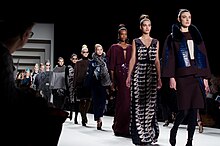
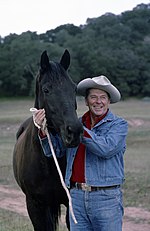
Fashion in the United States is eclectic and predominantly informal. While the diverse cultural roots of Americans are reflected in their clothing, particularly those of recent immigrants,cowboy hatsandboots,and leathermotorcycle jacketsare emblematic of specifically-American styles.[citation needed]
Blue jeanswere popularized as work clothes in the 1850s by merchantLevi Strauss,a German-Jewish immigrant in San Francisco, and adopted by many American teenagers a century later. They are worn in every state by people of all ages and social classes. Along with mass-marketed informal wear in general, blue jeans are arguably one of US culture's primary contributions to global fashion.[64]
Though the informal dress is more common, certain professionals, such asbankersandlawyers,traditionally dress formally for work, and some occasions, such asweddings,funerals,dances,and some parties, typically call forformal wear.[citation needed]The annualMet GalainManhattanis known worldwide as "fashion's biggest night".[65][66]
Some cities and regions have specialties in certain areas. For example, Miami for swimwear, Boston and the generalNew Englandarea for formal menswear, Los Angeles for casual attire and womenswear, and cities like Seattle and Portland for eco-conscious fashion. Chicago is known for its sportswear, and is the premier fashion destination in the middle American market. Dallas,Houston,Austin,Nashville,and Atlanta are big markets for thefast fashionand cosmetics industries, alongside having their own distinct fashion sense that mainly incorporates cowboy boots and workwear, greater usage of makeup, lighter colors and pastels, "college prep" style, sandals, bigger hairstyles, and thinner, airier fabrics due to the heat and humidity of the region.
The nuclear family and family structure
Family arrangements in the United States reflect thenatureof contemporaryAmerican society.The classicnuclear familyis a man and a woman, united in marriage, with one or more biological children.[67]Today, a person may grow up in a single-parent family, go on to marry and live in a childfree couple arrangement, then get divorced, live as a single for a couple of years, remarry, have children and live in a nuclear family arrangement.[26][68]
| Year | Families (69.7%) | Non-families (31.2%) | |||||
|---|---|---|---|---|---|---|---|
| Married couples (52.5%) | Single parents | Other blood relatives | Singles (25.5%) | Other non-family | |||
| Nuclear family | Without children | Male | Female | ||||
| 2000 | 24.1% | 28.7% | 9.9% | 7% | 10.7% | 14.8% | 5.7% |
| 1970 | 40.3% | 30.3% | 5.2% | 5.5% | 5.6% | 11.5% | 1.7% |
Youth dependence
Exceptions to the custom of leaving home when one reaches legal adulthood at age eighteen can occur especially among Italian and Hispanic Americans, and in expensive urban real estate markets such as New York City,[69]California,[70]andHonolulu,[71]where monthly rents commonly exceed $1,000 a month.
Marriage and divorce
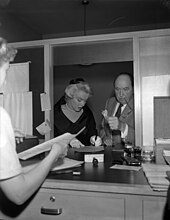
Marriage laws are established by individual states. The typical wedding involves a couple proclaiming their commitment to one another in front of their close relatives and friends, often presided over by a religious figure such as a minister, priest, or rabbi, depending upon the faith of the couple. In traditional Christian ceremonies, the bride's father will "give away" (handoff) the bride to the groom. Secular weddings are also common, often presided over by a judge,Justice of the Peace,or other municipal officials.Same-sex marriageis legal in all states since June 26, 2015.[citation needed]
Divorceis the province of state governments, so divorce law varies from state to state. Prior to the 1970s, divorcing spouses had to allege that the other spouse was guilty of a crime orsinlike abandonment or adultery; when spouses simply could not get along, lawyers were forced to manufacture "uncontested" divorces. Theno-fault divorcerevolution began in 1969 in California; New York and South Dakota were thelast states to begin allowing no-fault divorce.No-fault divorce on the grounds of "irreconcilable differences" is now available in all states. However, many states have recently required separation periods prior to a formal divorce decree.
State law provides forchild supportwhere children are involved, and sometimes foralimony."Married adults now divorce two-and-a-half times as often as adults did 20 years ago and four times as often as they did 50 years ago... between 40% and 60% ofnewmarriages will eventually end in divorce. The probability within... the first five years is 20%, and the probability of its ending within the first 10 years is 33%... Perhaps 25% of children (ages 16 and under) live with a stepparent. "[72]The median length for a marriage in the U.S. today is 11 years with 90% of all divorces being settled out of court.[citation needed]
Housing

Historically, Americans mainly lived in a rural environment, with a few important cities of moderate size. TheIndustrial Revolutionbrought a period ofurbanizationaccelerated by theGI Billthat incentivized soldiers returning from WWII to purchase a house in thesuburbs.
American cities with housing prices near the national median have also been losing themiddle incomeneighborhoods, those with median income between 80% and 120% of the metropolitan area's median household income. Here, the more affluent members of the middle-class, who are also often referred to as being professional orupper-middle-class,have left in search of larger homes in more exclusive suburbs. This trend is largely attributed to themiddle-class squeeze,which has caused a starker distinction between thestatistical middle classand the more privileged members of themiddle class.[73]In more expensive areas such as California, however, another trend has been taking place where an influx of more affluent middle-class households has displaced those in the actual middle of society and converted former Americanmiddle-middle-classneighborhoods intoupper-middle-classneighborhoods.[74]
Volunteerism
Alexis de Tocquevillefirst noted, in 1835, the American attitude towards helping others in need. A 2011Charities Aid Foundationstudy found that Americans were the first most willing to help a stranger and donate time and money in the world at 60%. Many low-level crimes are punished by assigning hours of "community service",a requirement that the offender perform volunteer work;[75]some high schools also require community service to graduate. Since US citizens are required to attendjury duty,they can be jurors in legal proceedings.
Drugs and alcohol
This sectionneeds additional citations forverification.(October 2012) |
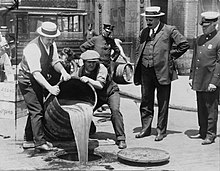
American attitudes towards drugs and alcoholic beverages have evolved considerably throughout the country's history. In the 19th century, alcohol was readily available and consumed, and no laws restricted the use of other drugs. Attitudes on drug addiction started to change, resulting in theHarrison Act,which eventually became proscriptive.
A movement to ban alcoholic beverages called theTemperance movement,emerged in the late 19th century. Several American Protestant religious groups and women's groups, such as theWomen's Christian Temperance Union,supported the movement. In 1919, Prohibitionists succeeded inamending the Constitutionto prohibit the sale of alcohol. Although the Prohibition period did result in a 50% decrease in alcohol consumption,[76]banning alcohol outright proved to be unworkable, as the previously legitimate distillery industry was replaced by criminal gangs that trafficked in alcohol. Prohibitionwas repealedin 1933. States and localities retained the right to remain "dry", and to this day,a handfulstill do.
During theVietnam Warera, attitudes swung well away from prohibition.[clarification needed]Commentators noted that an 18-year-old could bedraftedto war but could not buy a beer.[citation needed]
Since 1980, the trend has been toward greater restrictions on alcohol and drug use. The focus this time, however, has been to criminalize behaviors associated with alcohol, rather than attempt to prohibit consumption outright. New York was the first state to enact toughdrunk-drivinglaws in 1980; since then all other states have followed suit. All states have alsobanned the purchaseof alcoholic beverages by individuals under 21.
A "Just Say Noto Drugs "movement replaced the more liberal ethos of the 1960s. This led to stricter drug laws and greater police latitude in drug cases. Drugs are, however, widely available, and 16% of Americans 12 and older used an illicit drug in 2012.[77]
Since the 1990s,marijuanause has become increasingly tolerated in America, and a number of states allow theuse of marijuana for medical purposes.In most states marijuana is still illegal without a medical prescription. Since the 2012 general election, voters in the District of Columbia and the states ofAlaska,California,Colorado,Maine,Massachusetts,Nevada,Oregon,andWashingtonapproved the legalization of marijuana for recreational use. Marijuana is illegal under federal law.
Death and funerals
This sectionmay contain materialnot related to the topic of the article.(January 2013) |

It is customary for Americans to hold awakein afuneral homewithin a couple of days of the death of a loved one. The body of the deceased may beembalmedand dressed in fine clothing if there will be an open-casketviewing.Traditional Jewish and Muslim practices include a ritual bath and no embalming. Friends, relatives and acquaintances gather, often from distant parts of the country, to "pay their last respects" to the deceased. Flowers are brought to thecoffinand sometimeseulogies,elegies,personal anecdotes or group prayers are recited. Otherwise, the attendees sit, stand or kneel in quiet contemplation or prayer. Kissing the corpse on the forehead is typical among Italian Americans[78]and others.Condolencesare also offered to the widow or widower and other close relatives.
A funeral may be held immediately afterward or the next day. The funeral ceremony varies according to religion and culture. American Catholics typically hold afuneral massin a church, which sometimes takes the form of aRequiemmass. Jewish Americans may hold a service in a synagogue or temple.Pallbearerscarry the coffin of the deceased to thehearse,which then proceeds in aprocessionto the place of final repose, usually a cemetery. The uniqueJazz funeralof New Orleans features joyous and raucous music and dancing during the procession.
Mount Auburn Cemetery(founded in 1831) is known as "America's first garden cemetery."[79]Americancemeteriescreated since are distinctive for theirpark-like setting.Rows ofgravesare covered bylawnsand are interspersed with trees and flowers.Headstones,mausoleums,statuary or simple plaques typically mark off the individual graves.Cremationis another common practice in the United States, though it is frowned upon by various religions. The ashes of the deceased are usually placed in anurn,which may be kept in a private house, or they are interred. Sometimes the ashes are released into the atmosphere. The "sprinkling" or "scattering" of the ashes may be part of an informal ceremony, often taking place at a scenic natural feature (a cliff, lake or mountain) that was favored by the deceased.
Arts
Architecture
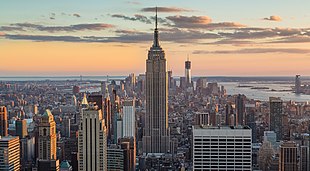
Architecture in the United States is regionally diverse and has been shaped by many external forces.U.S. architecturecan therefore be said to be eclectic.[80]Traditionally American architecture has influences fromEnglish architecture[81]toGreco Roman architecture.[82]The overriding theme of city American Architecture ismodernity, as manifest in the skyscrapersof the 20th century, with domestic and residential architecture greatly varying according to local tastes and climate,rural Americanandsuburbanarchitecture tends to be more traditional.
Visual arts
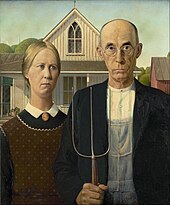
In the late-18th and early-19th centuries, American artists primarily painted landscapes andportraitsin a realistic style or that which looked to Europe for answers on technique: for example,John Singleton Copleywas born in Boston, but most of his portraiture for which he is famous follow the trends of British painters likeThomas Gainsboroughand the transitional period betweenRococoandNeoclassicism.The later 18th century was a time when the United States was just an infant as a nation and as far away from the phenomenon where artists would receive training as craftsmen byapprenticeshipand later seeking a fortune as a professional, ideally getting a patron: Many artists benefited from the patronage ofGrand Touristseager to procure mementos of their travels. There were no temples of Rome or grand nobility to be found in the Thirteen Colonies. Later developments of the 19th century brought America one of its earliest native homegrown movements, like theHudson River Schooland portrait artists with a uniquely American flavor likeWinslow Homer.

A parallel development taking shape in rural America was theAmerican craftmovement, which began as a reaction to theIndustrial Revolution.As the nation grew wealthier, it had patrons able to buy the works of European painters and attract foreign talent willing to teach methods and techniques from Europe to willing students as well as artists themselves; photography became a very popular medium for both journalism and in time as a medium in its own right with America having plenty of open spaces of natural beauty and growing cities in the East teeming with new arrivals and new buildings. Museums in New York,Boston,Philadelphia,andWashington, D.C.began to have a booming business in acquisitions, competing for works as diverse as the then more recent work of theImpressioniststo pieces fromancient Egypt,all of which captured the public imaginations and further influenced fashion and architecture. Developments in modern art in Europe came to America from exhibitions in New York City such as theArmory Showin 1913. After World War II, New York emerged as a center of the art world. Painting in the United States today covers a vast range of styles. American painting includes works byJackson Pollock,John Singer Sargent,Georgia O'Keeffe,andNorman Rockwell,among many others.
Literature
Theater and performing arts
Theater of the United States is based in the Western tradition. The United States originatedstand-up comedyandmodern improvisational theatre,which involves taking suggestions from the audience.
Minstrel show
Theminstrel show,though now widely recognized as racist and offensive, is also recognized as the first uniquely American theatrical art form. Minstrel shows were developed in the 19th century and they were typically performed by white actors wearingblackfacemakeup for the purpose of imitating and caricaturing the speech and music ofAfrican Americans.Stephen Fosterwas a famous composer for minstrel shows. Many of his songs such as "Camptown Races","Oh Susanna",and"My Old Kentucky Home"became popular American folk songs.Tap dancingandstand-up comedyhave origins in minstrel shows.[84]
Banjos,originally hand-made by slaves for entertainment onplantations,began to be mass-produced in the United States in the 1840s as a result of their extensive use on the minstrel stage.[85]
Drama
American theater did not take on a unique dramatic identity until the emergence ofEugene O'Neillin the early 20th century, now considered by many to be the father of American drama.[citation needed]O'Neill is a four-time winner of thePulitzer Prizefor drama and the only American playwright to win theNobel Prize in Literature.After O'Neill, American drama came of age and flourished with the likes ofArthur Miller,Tennessee Williams,Lillian Hellman,William Inge,andClifford Odetsduring the first half of the 20th century. After this fertile period, American theater broke new ground, artistically, with theabsurdist formsofEdward Albeein the 1960s.
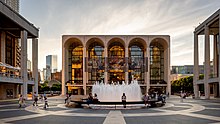
Social commentaryhas also been a preoccupation of American theater, often addressing issues not discussed in the mainstream. Writers such asLorraine Hansbury,August Wilson,David MametandTony Kushnerhave all wonPulitzer Prizesfor their polemical plays on American society.[86]
Musical theater

The United States is also the home and largest exporter of modernmusical theater,producing such musical talents asRodgers and Hammerstein,Lerner and Loewe,Cole Porter,Irving Berlin,Leonard Bernstein,GeorgeandIra Gershwin,Kander and Ebb,andStephen Sondheim.Broadwayis one of the largest theater communities in the world and is the epicenter of American commercial theater.
Music
American music styles and influences (such ascountry,jazz,blues,rock,pop,techno,soul,andhip hop) and music based on them can be heard all over the world. Music in the U.S. is very diverse, and the country has the world'slargest music marketwith a total retail value of $4.9 billion in 2014.[87]
The rhythmic and lyrical styles ofAfrican-American musichave significantly influenced American music at large, distinguishing it from European and African traditions. TheSmithsonian Institutionstates, "African-American influences are so fundamental to American music that there would be no American music without them."[88]Country musicdeveloped in the 1920s, andrhythm and bluesin the 1940s. Elements from folk idioms such as thebluesand what is known asold-time musicwere adopted and transformed intopopular genreswith global audiences.Jazzwas developed by innovators such asLouis ArmstrongandDuke Ellingtonearly in the 20th century.[89]Known for singing in a wide variety of genres,Aretha Franklinis considered one of the all-time greatest American singers.[90]
Elvis PresleyandChuck Berrywere among the pioneers ofrock and rollin the mid-1950s. Rock bands such asMetallica,theEagles,andAerosmithare among thehighest grossingin worldwide sales.[91][92][93]In the 1960s,Bob Dylanemerged from thefolk revivalto become one of America's most celebrated songwriters.[94]Mid-20th-century Americanpop starssuch asBing Crosby,Frank Sinatra,[95]and Elvis Presley became global celebrities,[89]as have artists of the late 20th century such asMichael Jackson,Madonna,Prince,Whitney Houston,andMariah Carey.[96][97]American professional opera singers have reached the highest level of success in that form, includingRenée Fleming,Leontyne Price,Beverly Sills,Nelson Eddy,and many others.
American popular music,as part of the wider U.S. pop culture, has a worldwide influence and following.[98]Madonna has sold themost records of any female artistin recorded musical history. As of 2022[update],Taylor Swift,Miley Cyrus,Ariana Grande,Eminem,Lady Gaga,Katy Perry,and many others contemporary artists dominateglobal streaming rankings.[99]
The annualCoachellamusic festival inCaliforniais one of the largest, most famous, and most profitable music festivals in the United States and the world.[100][101]
Cinema

The United States movie industry has a worldwide influence and following.Hollywood,a northern district of Los Angeles, California, is the leader in motion picture production and the most recognizable movie industry in the world.[102][103][104]Themajor film studiosof the United States are the primary source of themost commercially successfuland most ticket selling movies in the world.[105][106]
The dominant style of American cinema isclassical Hollywood cinema,which developed from 1913 to 1969 and is still typical of most films made there to this day. While FrenchmenAuguste and Louis Lumièreare generally credited with the birth of modern cinema,[107]American cinema soon came to be a dominant force in the emerging industry. The world's firstsync-soundmusical film,The Jazz Singer,was released in 1927,[108]and was at the forefront of sound-film development in the following decades.Orson Welles'sCitizen Kane(1941) is frequently cited in critics' polls as thegreatest film of all time.[109]
Broadcasting
This article needs to beupdated.(March 2023) |
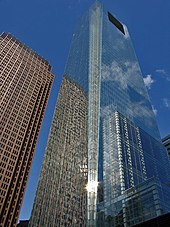
Television constitutes a significant part of the traditionalmedia of the United States.Household ownership of television sets in the country is 96.7%,[110]and the majority of households have more than one set. The peak ownership percentage of households with at least one television set occurred during the 1996–97 season, with 98.4% ownership.[111]As a whole, thetelevision networksof the United States is the largest and mostsyndicatedin the world.[112]
As of August 2013, approximately 114,200,000 American households own at least one television set.[113]
In 2014, due to a recent surge in the number and popularity of critically acclaimed television series, many critics have said that American television is currently enjoying a golden age.[114][115]
Philosophy
This sectionneeds additional citations forverification.(May 2023) |
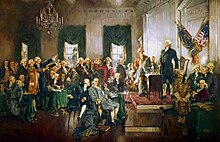
Early American philosophy was heavily shaped by the EuropeanAge of Enlightenment,which promoted ideals such as reason and individual liberty.[116]Enlightenment ideals influenced theAmerican Revolutionand theConstitution of the United States.Major figures in theAmerican EnlightenmentincludedThomas Jefferson,Benjamin Franklin,andThomas Paine.
Pragmatismandtranscendentalismare uniquely American philosophical traditions founded in the 19th century byWilliam JamesandRalph Waldo Emersonrespectively.Objectivismis a philosophical system founded byAyn Randwhich influencedlibertarianism.John Rawlspresented the theory of "justice as fairness"inA Theory of Justice(1971).
Willard Van Orman Quine,Saul Kripke,andDavid Lewishelped advancelogicandanalytic philosophyin the 20th century.Thomas Kuhnrevolutionized thephilosophy of sciencewith his bookThe Structure of Scientific Revolutions(1962), one of the most cited academic works of all time, and he coined the termparadigm shift.
Artificial intelligenceand thephilosophy of mindhave been heavily influenced by American philosophers such asDaniel Dennett,[117]Noam Chomsky,[118]Hilary Putnam,[119]Jerry Fodor,andJohn Searle,who contributed tocognitivism,thehard problem of consciousness,and themind-body problem.The Libet experiment created by American neuroscientistBenjamin Libetraised philosophical debate regarding theneuroscience of free will.TheChinese roomthought experiment presented by John Searle questions the nature of intelligence in machines, and it has been influential incognitive scienceand thephilosophy of artificial intelligence.
Politics
LGBT rights in the United Statesare comparatively advanced by world standards.[120][121][122]
Government
Law enforcement and crime
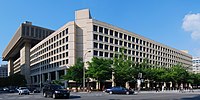
There are about 18,000 U.S. police agencies from local to federal level in the United States.[123]Law in the United States is mainlyenforcedby local police departments andsheriff's offices. Thestate policeprovides broader services, andfederal agenciessuch as theFederal Bureau of Investigation(FBI) and theU.S. Marshals Servicehave specialized duties, such as protectingcivil rights,national securityand enforcingU.S. federal courts' rulings and federal laws.[124]State courtsconduct most civil and criminal trials,[125]and federal courts handle designated crimes and appeals from the state criminal courts.[126]
As of 2023[update],the United States has thesixth-highest documented incarceration rateandsecond-largest prison populationin the world.[127]In 2019, the total prison population for those sentenced to more than a year was 1,430,800, corresponding to a ratio of 419 per 100,000 residents and the lowest since 1995.[128]Various states have attempted toreduce their prison populationsvia government policies and grassroots initiatives.[129]
U.S. police arecomparatively violent,with deaths in custody and fatal shootings being higher than in other developed countries.[130][131]
Military culture
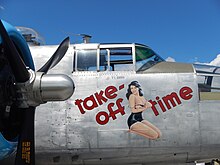
From the time of its inception, the military played a decisive role in thehistory of the United States.A sense of national unity and identity was forged out of the victoriousFirst Barbary War,Second Barbary War,and theWar of 1812.Even so, theFounderswere suspicious of a permanent military force and not until the outbreak ofWorld War IIdid a large standing army become officially established.[132]TheNational Security Act of 1947,adopted following World War II and during the onset of the Cold War, created the modern U.S. military framework;[133]the Act merged previously Cabinet-levelDepartment of Warand theDepartment of the Navyinto theNational Military Establishment(renamed the Department of Defense in 1949), headed by the Secretary of Defense; and created theDepartment of the Air Forceand National Security Council.[134]
Military service in the United States is voluntary, althoughconscriptionmay occur in wartime through theSelective Service System.[135]The United States has the third-largest combined armed forces in the world, behind theChinese People's Liberation ArmyandIndian Armed Forces.[136]The U.S. military operates about 800 bases and facilities abroad,[137]maintainainingdeployments greater than 100 active duty personnelin 25 foreign countries,[138]and possesses significant capabilities in both defense andpower projection.[139][140]
Gun culture
In sharp contrast to most other nations,firearms laws in the United States are permissive,and private gun ownership is common; almost half of American households contain at least one firearm.[142]The Supreme Court has ruled that theSecond Amendment to the United States Constitutionprotects an individual right to possess modern firearms, subject to reasonable regulation,[143]a view shared by the majority of Americans.
There are more privately owned firearms in the United States than in any other country, bothper capitaand in total.[144]Civilians in the United States possess about 42% of the global inventory of privately owned firearms.[145]Rates of gun ownership vary significantly by region and by state; gun ownership is most common in Alaska, theMountain States,andthe South,and least prevalent in Hawaii, theisland territories,California,andNew England.Across the board, gun ownership tends to be more common in rural than in urban areas.[146]
Hunting,plinking,andtarget shootingare popular pastimes, although ownership of firearms for purely utilitarian purposes such as personal protection is common as well. "Personal protection" was the most common reason given for gun ownership in a 2013 Gallup poll of gun owners, at 60%.[147]Ownership ofhandguns,while not uncommon, is less common than ownership oflong guns.Gun ownership is much more prevalent among men than among women, with men being approximately four times more likely than women to report owning guns.[148]
Society
Science and technology

There is a regard for scientific advancement and technological innovation in American culture, resulting in the creation of many modern innovations. The great American inventors includeRobert Fulton(thesteamboat);Samuel Morse(thetelegraph);Eli Whitney(thecotton gin,interchangeable parts);Cyrus McCormick(thereaper); andThomas Edison(with more than a thousand inventions credited to his name). Most of the new technological innovations over the 20th and 21st centuries were either first invented in the United States, first widely adopted by Americans, or both. Examples include thelightbulb,theairplane,thetransistor,theatomic bomb,nuclear power,thepersonal computer,theiPod,video games,online shopping,and the development of theInternet.[149]The United States also developed theGlobal Positioning System,which is the world's pre-eminentsatellite navigationsystem.[150]
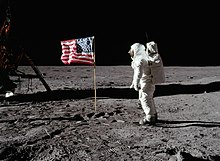
The United States has been a leader in technologicalinnovationsince the late 19th century and scientific research since the mid-20th century. Methods for producinginterchangeable partsand the establishment of amachine toolindustry enabled theU.S. to have large-scale manufacturingof sewing machines, bicycles, and other items in the late 19th century. In the early 20th century, factoryelectrification,the introduction of theassembly line,and other labor-saving techniques created the system ofmass production.This propensity for application of scientific ideas continued throughout the 20th century with innovations that held strong international benefits. The 20th century saw the arrival of theSpace Age,theInformation Age,and a renaissance in thehealth sciences.This culminated in cultural milestones such as theApollo Moon landings,the creation of thepersonal computer,and the sequencing effort called theHuman Genome Project.In the 21st century, approximately two-thirds of research and development funding comes from the private sector.[151]The U.S. had 2,944 activesatellitesin space in December 2021, the highest number of any country.[152]

Throughout its history, American culture has made significant gains through the open immigration of accomplished scientists. Accomplished scientists include Scottish American scientistAlexander Graham Bell,who developed and patented the telephone and other devices; German scientistCharles Steinmetz,who developed new alternating-current electrical systems in 1889; Russian scientistVladimir Zworykin,who invented the motion camera in 1919; Serb scientistNikola Teslawho patented a brushless electricalinduction motorbased on rotating magnetic fields in 1888. The rise offascismandNazismin the 1920s and 30s led many European scientists, such asAlbert Einstein,Enrico Fermi,andJohn von Neumann,to immigrate to the United States.[153]
Thomas Edison'sresearch laboratorydeveloped thephonograph,the firstlong-lasting light bulb,and the first viablemovie camera.[154]TheWright brothersin 1903 made thefirst sustained and controlled heavier-than-air powered flight,and the automobile companies ofRansom E. OldsandHenry Fordpopularized the assembly line in the early 20th century.[155]
Education
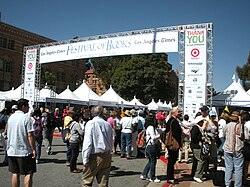
Education in the United States is and has historically been provided mainly by the government. Control and funding come from three levels:federal,state,andlocal.School attendance is mandatory and nearly universal at the elementary and high school levels (often known outside the United States as the primary and secondary levels).[citation needed]
Students have the option of having their education held inpublic schools,private schools, orhome school.In most public and private schools, education is divided into three levels:elementary school,junior high school(also often called middle school), andhigh school.In almost all schools at these levels, children are divided by age groups intogrades.Post-secondary education,better known as "college" in the United States, is generally governed separately from the elementary and high school systems.[citation needed]
In the year 2000, there were 76.6 million students enrolled in schools fromkindergartenthroughgraduate schools.Of these, 72 percent aged 12 to 17 were judged academically "on track" for their age (enrolled in school at or above grade level). Of those enrolled in compulsory education, 5.2 million (10.4 percent) were attending private schools. Among the country's adult population, over 85 percent have completed high school and 27 percent have received abachelor's degreeor higher.[156]

The large majority of the world's top universities, as listed by various ranking organizations, are in the United States, including 19 of the top 25, and the most prestigious –Harvard University.[158][159][160][161]The country also has by far the mostNobel Prize winnersin history, with 403 (having won 406 awards).[162]
Religion
Self-identified religious affiliation in the United States (2023The Wall Street Journal-NORCpoll)[163]
Amongdeveloped countries,the U.S. is one of the most religious in terms of its demographics. According to a 2002 study by thePew Global Attitudes Project,the U.S. was the only developed nation in the survey where a majority of citizens reported that religion played a "very important" role in their lives, an opinion similar to that found in Latin America.[164]Today, governments at the national, state, and local levels aresecularinstitutions, with what is often called the "separation of church and state".The most popular religion in the U.S. isChristianity,comprising the majority of the population (73.7% of adults in 2016).[165][166]
Although participation in organized religion has been diminishing, the public life andpopular cultureof the United States incorporates many Christian ideals specifically about redemption, salvation, conscience, and morality. Examples are popular culture obsessions with confession and forgiveness, which extends fromreality televisiontotwelve-step meetings.[167]
Self-identified religiosity (2023The Wall Street Journal-NORCpoll)[168]
Most of theBritishThirteen Colonieswere generally not tolerant of dissident forms of worship. Civil and religious restrictions were most strictly applied by thePuritansof theMassachusetts Bay Colonywhich saw various banishments applied to enforce conformity, including thebranding iron,thewhipping post,thebilboesand thehangman's noose.[169]The persecuting spirit was shared byPlymouth Colonyand the colonies along theConnecticut river.[170]Mary Dyerwas one of the four executedQuakersknown as theBoston martyrs,and her death on the Boston gallows marked the beginning of the end of Puritantheocracyand New England independence from English rule; in 1661 Massachusetts was forbidden from executing anyone for professing Quakerism.[171]Anti-Catholicsentiment appeared in New England with the firstPilgrimand Puritan settlers.[172]The Pilgrims of New England held radical Protestant disapproval ofChristmas.[173]Christmas observance was outlawed inBostonin 1659.[174]The ban by the Puritans was revoked in 1681 by an English appointed governor; however, it was not until the mid-19th century that celebrating Christmas became common in the Boston region.[175]
Thecolony of Maryland,founded by the CatholicLord Baltimorein 1634, came closest to applying freedom of religion.[176]Fifteen years later (1649), theMaryland Toleration Act,drafted by Lord Baltimore, provided: "No person or persons...shall from henceforth be any waies troubled, molested or discountenanced for or in respect of his or her religion nor in the free exercise thereof." The Act allowed freedom of worship for allTrinitarianChristians in Maryland, butsentenced to deathanyone who denied the divinity ofJesus.
Modeling the provisions concerning religion within theVirginia Statute for Religious Freedom,the framers of theUnited States Constitutionrejected any religious test for office, and theFirst Amendmentspecifically denied the central government any power to enact any law respecting either an establishment of religion or prohibiting its free exercise. In the following decades, the animating spirit behind the constitution'sEstablishment Clauseled to the disestablishment of the official religions within the member states. The framers were mainly influenced by secular,Enlightenmentideals, but they also considered the pragmatic concerns of minority religious groups who did not want to be under the power or influence of astate religionthat did not represent them.[177]Thomas Jefferson,author of theDeclaration of Independencesaid: "The priest has been hostile to liberty. He is always in alliance with the despot."[178]
Galluppolls during the early 2020s found that about 81% of Americans believe in some conception of aGodand 45% reportprayingon a daily basis.[179][180][181]According to their poll in December 2022, "31% report attending a church, synagogue, mosque or temple weekly or nearly weekly today."[181]In the "Bible Belt",which is located primarily within theSouthern United States,socially conservativeevangelical Protestantismplays a significant role culturally.New Englandand theWestern United Statestend to be less religious.[182]Around 6% of Americans claim a non-Christian faith;[183]the largest of which areJudaism,Islam,Hinduism,andBuddhism.[184]The United States eitherhas the first or second-largest Jewish populationin the world, and the largest outside ofIsrael.[185]"Ceremonial deism"is common in American culture.[186][187]
Around 30% of Americans describe themselves as havingno religion.[183]Membership in a house of worship fell from 70% in 1999 to 47% in 2020, much of the decline related to the number of Americans expressing no religious preference. Membership also fell among those who identified with a specific religious group.[188][189]According toGallup,trust in "the church or organized religion" has declined significantly since the 1970s.[190]According to the 2022Cooperative Election Study,younger Americans are significantly less religious. AmongGeneration Z,a near-majority consider themselvesatheist,agnostic,ornothing in particular.[191]
Social class and work

Though the majority of Americans in the 21st century identify themselves asmiddle class,American society has experienced increasedincome inequality.[26][192][193]Social class, generally described as a combination ofeducational attainment,incomeand occupational prestige, is one of the greatest cultural influences in America.[26]Nearly all cultural aspects of mundane interactions and consumer behavior in the U.S. are guided by a person's location within the country'ssocial structure.
Distinct lifestyles, consumption patterns and values are associated with different classes. Early sociologist-economistThorstein Veblen,for example, said that those at the top of the societal hierarchy engage inconspicuous leisureandconspicuous consumption.Upper classAmericans commonly have eliteIvy Leagueeducationsand are traditionally members of exclusive clubs and fraternities with connections tohigh society,distinguished by their enormous incomes derived from their wealth inassets.The upper-class lifestyle and values often overlap with that of the upper middle class, but with more emphasis on security and privacy in home life and forphilanthropy(i.e. the "Donor Class") andthe arts.Due to their large wealth (inherited or accrued over a lifetime of investments) and lavish, leisurely lifestyles, the upper class are more prone toidleness.The upper middle class, or the "working rich",[194]commonly identify education and being cultured as prime values, similar to the upper class. Persons in this particularsocial classtend to speak in a more direct manner that projects authority, knowledge and thus credibility. They often tend to engage in the consumption of so-called mass luxuries, such asdesigner labelclothing. A strong preference for natural materials, organic foods, and a strong health consciousness tend to be prominent features of the upper middle class.American middle-classindividuals in general value expanding one's horizon, partially because they are more educated and can afford greater leisure and travel. Working-class individuals take great pride in doing what they consider to be "real work" and keep very close-knit kin networks that serve as a safeguard against frequent economic instability.[26][195][196]
Working-class Americans and many of those in the middle class may also face occupation alienation. In contrast to upper-middle-class professionals who are mostly hired to conceptualize, supervise, and share their thoughts, many Americans have little autonomy or creative latitude in the workplace.[197]As a result, white collar professionals tend to be significantly more satisfied with their work.[198][199]In 2006,Elizabeth Warrenpresented her article entitled "The Middle Class on the Precipice", stating that individuals in the center of the income strata, who may still identify as middle class, have faced increasing economic insecurity,[200]supporting the idea of a working-class majority.[201]Additionally, working-class Americans who work in the public sector, excluding politicians, are respected and generally respected in the culture, notably postal workers.[202][203]

Political behavior is affected by class; more affluent individuals are more likely to vote, and education and income affect whether individuals tend to vote for the Democratic or Republican party.Incomealso had a significant impact on health as those with higherincomeshad better access to health care facilities, higherlife expectancy,lowerinfant mortality rateand increased health consciousness.[205][206][207]This is particularly noticeable with black voters who are often socially conservative, yet overwhelmingly vote Democratic.[208][209]
In the United States, occupation is one of the prime factors ofsocial classand is closely linked to an individual's identity. The average workweek in the U.S. for those employed full-time was 42.9 hours long with 30% of the population working more than 40 hours a week.[210]The Average American worker earned $16.64 an hour in the first two quarters of 2006.[211]Overall Americans worked more than their counterparts in other developed post-industrial nations. While the average worker in Denmark enjoyed 30 days of vacation annually, the average American had 16 annual vacation days.[212]
In 2000, the average American worked 1,978 hours per year, 500 hours more than the average German, yet 100 hours less than the averageCzech.Overall, the U.S. labor force is one of the most productive in the world, largely due to its workers working more than those in any other post-industrial country, except for South Korea.[213]Americans generally hold working and being productive in high regard.[196]Individualism,[214]having a strongwork ethic,[215]competitiveness,[216]andaltruism[217][218][219]are among the most cited American values. According to a 2016 study by theCharities Aid Foundation,Americans donated 1.44% of total GDP to charity, thehighestin the world by a large margin.[220]
Race, ancestry, and immigration

The United States has anethnically diversepopulation, and 37 ancestry groups have more than one million members.[223]White Americanswith ancestry from Europe, the Middle East or North Africa, form the largestracialandethnic groupat 57.8% of the U.S. population.[224][225]Hispanic and Latino Americansform the second-largest group and are 18.7% of the U.S. population.African Americansconstitute the nation's third-largest ancestry group and are 12.1% of the total U.S. population.[223]Asian Americansare the country's fourth-largest group, composing 5.9% of the U.S. population, while the country's 3.7 millionNative Americansaccount for about 1%.[223]In 2020, the median age of the U.S. population was 38.5 years.[226]
According to theUnited Nations,the U.S. has the highestnumber of immigrant populationin the world, with 50,661,149 people.[227][228]In 2018, there were almost 90 million immigrants andU.S.-born children of immigrantsin the U.S., accounting for 28% of the overall U.S. population.[229]In 2017, out of the U.S. foreign-born population, some 45% (20.7 million) were naturalized citizens, 27% (12.3 million) were lawful permanent residents, 6% (2.2 million) were temporary lawful residents, and 23% (10.5 million) were unauthorized immigrants.[230]The U.S. led the world inrefugee resettlementfor decades, admitting more refugees than the rest of the world combined.[231]
Race in the U.S. is based on physical characteristics, such as skin color, and has played an essential part in shaping American society even before the nation's conception.[26]Until thecivil rights movementof the 1960s, racial minorities in the U.S. facedinstitutional discriminationand both social and economic marginalization.[232]TheU.S. Census Bureaucurrently recognizes five racial groupings: White, African, Native, Asian, andPacific Islander.According to the U.S. government, Hispanic Americans do not constitute a race, but rather an ethnic group. During the2000 U.S. census,Whites made up 75.1% of the population; those who are Hispanic or Latino constituted the nation's prevalent minority with 12.5% of the population. African Americans made up 12.3% of the total population, 3.6% were Asian American, and 0.7% were Native American.[233]

With its ratification on December 6, 1865, theThirteenth Amendment to the U.S. Constitutionabolished slavery in the U.S. The Northern states had outlawed slavery in their territory in the late 18th and early 19th centuries, though their industrial economies relied on raw materials produced by slaves in the South. Following the Reconstruction period in the 1870s, racist legislation emerged in the Southern states named theJim Crow lawsthat provided for legal segregation. Lynching was practiced throughout the U.S., including in the Northern states, until the 1930s, while continuing well into the civil rights movement in the South.[232]
Chinese Americanswere earlier marginalized as well during a significant proportion of U.S. history. Between 1882 and 1943, the U.S. instituted theChinese Exclusion Actbarring all Chinese immigrants from entering the U.S. During theSecond World Waragainst theEmpire of Japan,roughly 120,000Japanese Americans,62% of whom were U.S. citizens,[234]were imprisoned inJapanese internment campsby the U.S. government following theattack on Pearl Harbor,an American military base, by Japanese forces in December 1941.
Due to exclusion from or marginalization by earlier mainstream society, there emerged a unique subculture among the racial minorities in the U.S. During the 1920s,Harlem,New York Citybecame home to theHarlem Renaissance.Music styles such asjazz,blues,rap,rock and roll,and numerous folk songs such asBlue Tail Fly (Jimmy Crack Corn)originated within the realms of African American culture and were later adopted by the mainstream.[232]Chinatownscan be found in many cities across the country and Asian cuisine has become a common staple in mainstream America. The Hispanic community has also had a dramatic impact on American culture. Today, Catholics are the largest religious denomination in the U.S. and outnumber Protestants in the Southwest and California.[235]Mariachi music and Mexican cuisine are commonly found throughout the Southwest, and some Latin dishes, such as burritos and tacos, are found practically everywhere in the nation.
Asian Americans havemedian household incomeandeducational attainmentexceeding that of other races. African Americans, Hispanics, and Native Americans have considerably lowerincomeand education than do White Americans or Asian Americans.[236][237]
Race relations
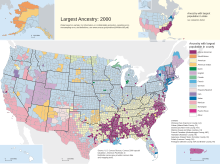
White Americans(non-Hispanic/LatinoandHispanic/Latino) are the racial majority and have a 72% share of the U.S. population, according to the 2010 U.S. census.[238]Hispanic and Latino Americans comprise 15% of the population, making up the largest ethnic minority.[239]Black Americansare the largest racial minority, comprising nearly 13% of the population.[238][239]TheWhite, non-Hispanic or Latino populationcomprises 63% of the nation's total.[239]
Throughout most of the country's history before and after its independence, the majority race in the United States has been Caucasian—aided by historic restrictions on citizenship and immigration—and the largest racial minority has been African Americans, most of whom are descended from slavessmuggled to the Americasby theEuropean colonial powers.This relationship has historically been the most important one since the founding of the United States. Slavery existed in the United States at the time of the country's formation in the 1770s. TheMissouri Compromisedeclared a policy of prohibiting slavery in the remaining Louisiana lands north of the36°30′ parallel.De facto,it sectionalized the country into two factions: free states, which forbid the institution of slavery; and slave states, which protected the institution. The Missouri Compromise was controversial, seen as lawfully dividing the country along sectarian lines. Although the federal governmentoutlawedAmerican participation in theAtlantic slave tradein 1807, after 1820, cultivation of the highly profitable cotton crop exploded in theDeep South,and along with it, the use of slave labor.[240][241][242]TheSecond Great Awakening,especially in the period 1800–1840, converted millions toevangelicalProtestantism. In the North, it energized multiple social reform movements, includingabolitionism;[243]in the South,MethodistsandBaptistsproselytized among slave populations.[244]
Slavery was partially abolished by theEmancipation Proclamationissued by the presidentAbraham Lincolnin 1862 for slaves in the Southeastern United States during theCivil War.With the United States' victory and preservation, slavery was abolished nationally by theThirteenth Amendment.Jim Crow lawsprevented full use of African American citizenship until thecivil rights movementin the 1960s, and theCivil Rights Act of 1964outlawed official or legal segregation at any level and forbid placing limitations on minorities' access to public places.
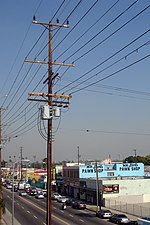
In 1882, in response to Chinese immigration due to theGold Rushand the labor needed for the transcontinental railroad, the government signed into law theChinese Exclusion Actwhich banned immigration by Chinese people into the U.S. In the late 19th century, the growth of the Hispanic population in the U.S., fueled largely by Mexican immigration, generated debate over policies such as English as the official language and reform to immigration policies. TheImmigration Act of 1924established the National Origins Formula as the basis of U.S. immigration policy, largely to restrict immigration fromAsia,Southern Europe,andEastern Europe.According to theOffice of the Historianof the U.S. Department of State, the purpose of the 1924 Act was "to preserve the ideal of U.S. homogeneity".[245]In 1924, Indian-bornBhagat Singh Thindwas twice denied citizenship as he was not deemed white.[246]Marking a radical break from U.S. immigration policies of the past, theImmigration and Nationality Act of 1965opened entry to the U.S. to non-Germanic groups.[247]This Act significantly altered the demographic mix in the U.S. as a result, creating a modern, diverse America.[247]
A huge majority of Americans of all races disapprove of racism. Nevertheless, some Americans continue to hold negative racial/ethnicstereotypesabout various racial and ethnic groups. Professor Imani Perry, ofPrinceton University,has argued that contemporary racism in the United States "is frequently unintentional or unacknowledged on the part of the actor",[248]believing that racism mostly stems unconsciously from below the level of cognition.[249]
Transport
Automobiles and commuting

Personal transportation is dominated by automobiles, which operate on a network of 4 million miles (6.4 million kilometers) of public roads, making it thelongest networkin the world.[250][251]In 2001, 90% of Americans drove to work by car.[252]As of 2022, the United States is thesecond-largestmanufacturer of motor vehicles[253]and is home toTesla,the world's most valuable car company.[254]General Motorsheld the title of the world's best-selling automaker from 1931 to 2008.[255]Currently, the U.S. has the world's second-largest automobile market by sales[256]and thehighestvehicle ownership per capita in the world, with 816.4 vehicles per 1,000 Americans (2014).[257]In 2017, there were 255 million non-two wheel motor vehicles, or about 910 vehicles per 1,000 people.[258]
Beginning in the 1990s, lower energy and land costs favor the production of relativelylarger cars,leading to a decline ineconomy cars.The culture in the 1950s and 1960s often catered to the automobile withmotelsanddrive-in restaurants.Outside of the relatively few urban areas, it is considered a necessity for most Americans to own and drive cars. New York City is the only locality in the United States where more than half of all households do not own a car.[252]In a car-dependent America, there is a common dislike ofcar dealershipsandcar salesmen,with only 10 percent of U.S. citizens in aGalluppoll rating them highly honest.[259]MatildabyRoald Dahlgives an example of this stereotype:Matilda's fathersellsused carsby filling their engines with sawdust or reversing theirodometerswith a drill.
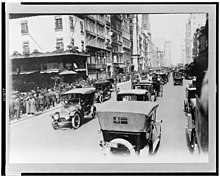
The United States emerged as a pioneer of theautomotive industryin the early 20th century.General Motors Corporation(GM), the company that would soon become the world's largest automaker, was founded in 1908 byWilliam Durant.[260]The U.S. also became the first country in the world to have a mass market for vehicle production and sales, and mass market production process.[261][262]In the 1950s and 1960s,subculturesbegan to arise around the modification and racing of American automobiles and converting them intohot rods.Later, in the late-1960s and early-1970s Detroit manufacturers began makingmuscle carsandpony carsto cater to wealthier Americans seeking hot rod style & performance. This culture has evolved into a worldwide phenomenon for car enthusiasts of today, and theproject caris a common sight in American suburbs.[citation needed]
Cultural institutions
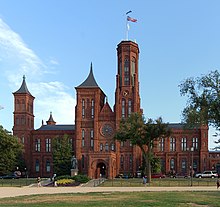
Governmental culture institutions
The United States government does not have aministry of culture,but there are a number of governmentinstitutions with cultural responsibilities,including thePresident's Committee on the Arts and Humanities,theFederal Communications Commission,theCorporation for Public Broadcasting,theNational Endowment for the Humanities,theNational Endowment for the Arts,theInstitute of Museum and Library Services,theU.S. Commission of Fine Arts,theLibrary of Congress,theSmithsonian Institution,and theNational Gallery of Art.
Many state and city governments have a department dedicated to cultural affairs.
National Register of Historic Places
TheNational Register of Historic Places(NRHP) is theUnited States federal government's officiallistofdistricts,sites, buildings, structures, and objects deemed worthy ofpreservationfor their historical significance or "great artistic value." For most of its history, the National Register has been administered by theNational Park Service(NPS), an agency within theU.S. Department of the Interior.
Non-governmental culture institutions
Major private US-based culture institutions include thePoetry Foundation,theSolomon R. Guggenheim Foundation,theJ. Paul Getty Trust,and theAndrew W. Mellon Foundation.
Museums
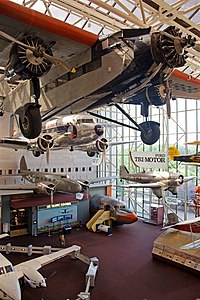
In the United States, there are manymuseums,both public and private. Major museums in the US include theMetropolitan Museum of Art,theMuseum of Modern Art,themuseums of the Smithsonian Institution,theAmerican Museum of Natural History,theArt Institute of Chicago,andThe Getty Museum.
Archives
There are various archives in the United States for the preservation of history and culture, such as theNational Archives and Records Administration.
See also
- 1950s American automobile culture
- African-American culture
- American studies
- American exceptionalism
- American Dream
- Americanization
- Americana
- Society of the United States
- Etiquette in North America
- Folklore of the United States
- Philanthropy in the United States
- Stereotypes of Americans
References
- ^"U.S. Culture".International Students and Scholars Office.Retrieved2024-03-13.
- ^"Official language of the United States | USAGov".www.usa.gov.Retrieved2024-05-20.
- ^Woodard, Colin (2018-07-30)."The Maps That Show That City vs. Country Is Not Our Political Fault Line".The New York Times.ISSN0362-4331.Retrieved2023-12-06.
- ^Coleman, Gabriella(2013).Coding Freedom.Princeton University Press.pp. 10, 201.ISBN978-0-691-14461-0.
- ^"Held Dear In U.S., Free Speech Perplexing Abroad".National Public Radio.September 19, 2012.RetrievedMarch 4,2023.
- ^Liptak, Adam (June 11, 2008)."Hate speech or free speech? What much of West bans is protected in U.S.".The New York Times.RetrievedFebruary 21,2023.
- ^Durkee, Alison (April 25, 2018)."What if we didn't... have the First Amendment?".Mic.RetrievedFebruary 6,2023.
- ^Wike, Richard."Americans more tolerant of offensive speech than others in the world".Pew Research Center.RetrievedFebruary 6,2023.
- ^Gray, Alex (November 8, 2016)."Freedom of speech: which country has the most?".World Economic Forum.RetrievedFebruary 6,2023.
- ^Hall, Ford W. (1950). "The Common Law: An Account of Its Reception in the United States".Vanderbilt Law Review.4:791.
- ^Inglehart, Ronald; Welzel, Chris."The WVS Cultural Map of the World".WVS. Archived fromthe originalon October 19, 2013.Retrieved6 October2014.
- ^Norris, Pippa(February 2023)."Cancel Culture: Myth or Reality?".Political Studies.71(1): 145–174.doi:10.1177/00323217211037023.ISSN0032-3217.S2CID238647612.
As predicted, in post-industrial societies, characterized by predominately liberal social cultures, like the US, Sweden, and UK...
- ^Staff (December 6, 2023)."WVS Database: Findings".World Values Survey.Retrieved2023-12-06.
These maps indicate that the United States is not a prototype of cultural modernization for other societies to follow, as some modernization writers assumed. In fact, the United States is a deviant case, having a much more traditional value system than any other postindustrial society except Ireland. On the traditional/secular dimension, the United States ranks far below other rich societies, with levels of religiosity and national pride comparable with those found in some developing societies. The United States does rank among the most advanced societies on the survival/self-expression dimension...
- ^ab"Country Profile: United States of America".BBC News.London. April 22, 2008.RetrievedMay 18,2008.
- ^abFergie, Dexter (March 24, 2022)."How American Culture Ate the World".The New Republic.ISSN0028-6583.RetrievedJuly 3,2022.
- ^The American Revolution, Colin Bonwick, 1991, p. 254
- ^Becoming America, Jon Butler, 2000, pp. 9–11
- ^The Encyclopedia of Colonial and Revolutionary America, Ed. John Mack Faragher, 1990, pp. 200–202
- ^ab"Mr. Jefferson and the giant moose: natural history in early America",Lee Alan Dugatkin. University of Chicago Press, 2009.ISBN0-226-16914-6,ISBN978-0-226-16914-9.University of Chicago Press, 2009. Chapter x.
- ^Kirschbaum, Erik (1986).The eradication of German culture in the United States, 1917–1918.H.-D. Heinz. p. 155.ISBN978-3-88099-617-5.
- ^Fraizer, Martin (July 8, 2005)."Continuity and change in Caribbean immigration".People's World.Retrieved6 May2014.
- ^"Preserving Native Languages: No Time to Waste".www.acf.hhs.gov.Retrieved2023-03-15.
- ^"Most Commonly Spoken Native American/First Nations Languages".Native-languages.org.RetrievedOctober 17,2017.
- ^McDonald, James (2010)Interplay:Communication, Memory, and Media in the United States.Goettingen: Cuvillier, p. 120.ISBN3-86955-322-7.
- ^Adams, J.Q.; Strother-Adams, Pearlie (2001).Dealing with diversity: the anthology.Chicago: Kendall/Hunt Pub.ISBN978-0-7872-8145-8.
- ^abcdefThompson, William E.; Hickey, Joseph V. (2004).Society in focus: an introduction to sociology(5th ed.). Boston: Pearson/Allyn and Bacon.ISBN978-0-205-41365-2.
- ^Stead, W. T. (1901).The Americanization of the World.Horace Markley. p. 393.
- ^Berghahn, Volker R. (2010-02-01)."The debate on 'Americanization' among economic and cultural historians".Cold War History.10(1): 107–130.doi:10.1080/14682740903388566.ISSN1468-2745.S2CID144459911.
- ^Woodard, Colin (2012).American Nations:a history of the eleven rival regional cultures of North America.A Penguin book History. New York: Penguin books.ISBN978-0-670-02296-0.
- ^"A Balkanized Federation".Nationhood Lab.Retrieved2023-12-27.
- ^"American Religious Identification Survey".gc.cuny.edu.Archived fromthe originalon July 9, 2011.
- ^Hine, Darlene; Hine, William C.; Harrold, Stanley (2006).The African American Odyssey.Boston, MA: Pearson.
- ^abGambino, Christine P., Yesenia D. Acosta, and Elizabeth M. Grieco. 2018 August 3. "English-Speaking Ability of the Foreign-Born Population in the United States: 2012ArchivedJanuary 25, 2021, at theWayback Machine"(revised). U.S. Census Bureau.
- ^"Selected Social Characteristics in the United States: 2007".United States Census Bureau.Archived fromthe originalon February 11, 2020.Retrieved2008-10-09.
- ^"United StatesArchivedMarch 21, 2021, at theWayback Machine."CIA World Factbook.2020 December 17.
- ^The CHOW Editorial Team (June 19, 2008)."The Hamburger Through Time".CBS INTERACTIVE INC. Archived fromthe originalon April 30, 2012.RetrievedApril 16,2012.
- ^Glazed America: Anthropologist Examines Doughnut as Symbol of Consumer CultureArchivedJanuary 22, 2009, at theWayback MachineNewswise, Retrieved on July 22, 2008.
- ^abKlapthor, James N. (August 23, 2003)."What, When, and Where Americans Eat in 2003".Institute of Food Technologists. Archived fromthe originalon April 18, 2008.Retrieved2007-06-19.
- ^Adams, J.Q.; Strother-Adams, Pearlie (2001).Dealing with Diversity.Chicago, IL: Kendall/Hunt Publishing Company.ISBN978-0-7872-8145-8.
- ^"History of the hot dog".Archived fromthe originalon October 18, 2006.Retrieved2006-11-13.
- ^"History of the Hamburger".Archived fromthe originalon November 21, 2006.Retrieved2006-11-13.
- ^"Coffee Today".Coffee Country.PBS. May 2003.Retrieved2007-06-19.
- ^Smith, Andrew F. (2004).The Oxford Encyclopedia of Food and Drink in America.New York: Oxford University Press, pp. 131–32.ISBN0-19-515437-1.Levenstein, Harvey (2003).Revolution at the Table: The Transformation of the American Diet.Berkeley, Los Angeles, and London: University of California Press, pp. 154–55.ISBN0-520-23439-1.Pirovano, Tom (2007)."Health & Wellness Trends—The Speculation Is Over".AC Nielsen. Archived fromthe originalon August 7, 2007.Retrieved2007-06-12.
- ^Isganaitis, Elvira; Lustig, Robert H. (2005)."Fast Food, Central Nervous System Insulin Resistance, and Obesity".Arteriosclerosis, Thrombosis, and Vascular Biology.25(12). American Heart Association: 2451–2462.doi:10.1161/01.ATV.0000186208.06964.91.PMID16166564.Retrieved2007-06-09."Let's Eat Out: Americans Weigh Taste, Convenience, and Nutrition"(PDF).U.S. Dept. of Agriculture. Archived fromthe original(PDF)on April 20, 2015.Retrieved2007-06-09.
- ^Karen DeBres, "A Cultural Geography of McDonald's UK," Journal of Cultural Geography, 2005
- ^Breadsley, Eleanor (January 24, 2012)."Why McDonald's in France Doesn't Feel Like Fast Food".NPR.RetrievedJanuary 15,2015.
- ^"When Was the First Drive-Thru Restaurant Created?".Wisegeek.org.RetrievedJanuary 15,2015.
- ^"Brief History of Physical Education".Excite.com.Archived fromthe originalon March 16, 2019.RetrievedMay 31,2015.
- ^"Poll: Adults who follow at least one sport".Harris Interactive.Archived fromthe originalon October 29, 2011.RetrievedNovember 5,2011.
- ^Krane, David K. (October 30, 2002)."Professional Football Widens Its Lead Over Baseball as Nation's Favorite Sport".Harris Interactive. Archived fromthe originalon January 4, 2009.RetrievedSeptember 14,2007.Maccambridge, Michael (2004).America's Game: The Epic Story of How Pro Football Captured a Nation.New York: Random House.ISBN0-375-50454-0.
- ^"Raw Numbers: The NHL's Impact on the South".The United States of Hockey. May 19, 2011.Retrieved2012-06-05.
- ^Mackovich, Ron (January 29, 2018)."United Airlines Memorial Coliseum to be new name for L.A. landmark".USC News.
- ^"Soccer will never be America's sport".USA Today.
- ^"Amid 40th anniversary of Title IX, women set a new standard in London".CNN.August 12, 2012. Archived fromthe originalon December 3, 2013.
- ^Federal Holidays CalendarsArchivedFebruary 12, 2010, at theWayback Machinefrom the federalOffice of Personnel Management.
- ^"5 USC § 6103 – Holidays | LII / Legal Information Institute".Law.cornell.edu.Retrieved2012-06-03.
- ^"Ask Civics 101: Why Is The Holiday Called 'Juneteenth,' And What Is The Significance?".New Hampshire Public Radio.2021-06-24.Retrieved2021-10-04.
- ^"Section 1-3-8".Legislature.state.al.us.Archived fromthe originalon July 27, 2013.RetrievedOctober 17,2017.
- ^"Holidays Observed".South Dakota Public Utilities Commission. Archived fromthe originalon August 14, 2007.
- ^"State agencies remain open for Discoverers Day".The Honolulu Advertiser.October 8, 2007.Retrieved2012-06-03.
- ^Larson, Carlton F.W. (November 2011)."Naming Baby: The Constitutional Dimensions of Naming Rights"(PDF).George Washington Law Review.80(1).
- ^abWattenberg, Laura (May 7, 2013).The Baby Name Wizard, Revised 3rd Edition: A Magical Method for Finding the Perfect Name for Your Baby.Harmony.ISBN978-0770436476.
- ^Rosenkrantz, Linda (August 29, 2006).Beyond Jennifer & Jason, Madison & Montana: What to Name Your Baby Now.St. Martin's Press.
- ^Davis Fred (1992).Fashion, Culture, and Identity
- ^Ali Bauman (May 1, 2023)."Met Gala 2023: Fashion's biggest night honors Karl Lagerfeld".CBS News.RetrievedAugust 13,2024.
- ^"Met Gala 2024: How to Watch Fashion's Biggest Night".Glamour.April 29, 2024.RetrievedAugust 13,2024.
- ^"The nuclear family is still indispensable".American Enterprise Institute – AEI.Retrieved2023-03-12.
- ^Williams, Brian; Sawyer, Stacey C.; Wahlstrom, Carl M. (2005).Marriages, Families & Intimate Relationships.Boston, MA: Pearson.ISBN978-0-205-36674-3.
- ^New York apartments pricing and New York NY apartment reviewsArchivedDecember 21, 2010, at theWayback MachineApartment Ratings
- ^San Francisco apartments pricing and San Francisco CA apartment reviewsArchivedJuly 7, 2011, at theWayback MachineApartment Ratings
- ^"Honolulu apartments pricing and Honolulu HI apartment reviews".Apartmentratings.com.Retrieved2012-06-03.
- ^Brian K. Williams, Stacy C. Sawyer, Carl M. Wahlstrom,Marriages, Families & Intimate Relationships,2005
- ^Harden, Blaine (June 22, 2006)."Washington Post, America is losing its middle-income neighborhoods".The Washington Post.Retrieved2006-07-25.
- ^Harden, Blaine (June 22, 2006)."Washington Post, America is losing its middle income neighborhoods".The Washington Post.Retrieved2006-07-25.
- ^Crary, David (September 9, 2010)."Study finds Americans in generous mood".Burlington, Vermont: Burlington Free Press. pp. 1A.
- ^"US drinking more now than just before Prohibition".Associated Press.April 28, 2021.
- ^"National Survey of Drug Use and Health".RetrievedNovember 24,2013.
- ^"The Italian Way of Death".Salon.com.Archived fromthe originalon May 3, 2009.Retrieved2009-10-08.
- ^Bunting, Bainbridge; Nylander, Robert H. (1973).Old Cambridge.Cambridge, Mass.: Cambridge Historical Commission. p. 69.ISBN978-0-262-53014-9.
- ^Dell Upton.1998.Architecture in the United States.pp. 11 ff.ISBN0-19-284217-X
- ^"Explore by Timeline: Colonial America and the Revolution (1565–1783)".www.gsa.gov.Retrieved2021-10-18.
- ^"Greek and Roman Influences on Washington, D.C. Architecture".www.milrose.com.Retrieved2021-10-18.
- ^Güner, Fisun (February 8, 2017)."How American Gothic became an icon".BBC.RetrievedAugust 13,2024.
- ^minstrel showRetrieved 6 June 2023
- ^Sabatella, Matthew."Banjo: A Brief History".balladofamerica.org.Retrieved1 May2023.
William Boucher, Jr., the earliest known commercial manufacturer, started building banjos around 1845 from his shop in Baltimore, Maryland.
- ^theatre-artRetrieved 6 June 2023
- ^"RIAJ Yearbook 2015: IFPI 2013, 2014 Report: 28. Global Sales of Recorded Music (Page 24)"(PDF).Recording Industry Association of Japan.Retrieved2016-03-20.
- ^"Musical Crossroads: African American Influence on American Music".Smithsonian.22 September 2016.RetrievedApril 14,2023.
- ^abBiddle, Julian (2001).What Was Hot!: Five Decades of Pop Culture in America.New York: Citadel. p.ix.ISBN978-0-8065-2311-8.
- ^"Why Aretha was the greatest singer in US history".BBC.RetrievedApril 14,2023.
- ^Hartman, Graham (January 5, 2012)."Metallica's 'Black album' is Top-Selling Disc of last 20 years".Loudwire.RetrievedOctober 12,2015.
- ^Vorel, Jim (September 27, 2012)."Eagles tribute band landing at Kirkland".Herald & Review.RetrievedOctober 12,2015.
- ^"Aerosmith will rock Salinas with July concert".February 2, 2015.RetrievedOctober 12,2015.
- ^"No. 1 Bob Dylan".Rolling Stone.April 10, 2020.RetrievedJanuary 29,2021.
- ^"10 ways that Frank Sinatra changed the world".USA Today.December 8, 2015.RetrievedJune 24,2021.
- ^"Whitney Houston's Global Impact".CNN.February 13, 2012.RetrievedJune 24,2021.
- ^"How Prince and his music challenged the music industry".Global News.RetrievedJune 25,2016.
- ^Ewen, David (1957).Panorama of American Popular Music.Prentice Hall.ISBN0-13-648360-7.pg. 3Of all the contributions made by Americans to world culture—automation and the assembly line, advertising, innumerable devices and gadgets, skyscrapers, supersalesmen, baseball, ketchup, mustard and hot dogs and hamburrgers—one, undeniably native has been taken to heart by the entire world. It is American popular music.
- ^Spangler, Todd (November 30, 2022)."Spotify Launches Wrapped 2022: Bad Bunny, Taylor Swift Are Most-Streamed Artists of the Year".Variety.Archivedfrom the original on November 30, 2022.RetrievedNovember 30,2022.
- ^Martens, Todd (April 8, 2014)."Goldenvoice releases Coachella set times, adds to the lineup".Los Angeles Times.Archivedfrom the original on April 10, 2014.RetrievedApril 9,2014.
- ^"7 Top Music Festivals Around The World – Tripoetic Blog".Tripoetic Blog.January 31, 2017.Archivedfrom the original on February 23, 2017.RetrievedFebruary 23,2017.
- ^Annual Report of the Controller of the City of Los Angeles, California.ByOffice of ControllerLos Angeles, CA (1914). 1914.RetrievedFebruary 22,2014.
- ^Report of the Auditor of the City of Los Angeles California of the Financial Affairs of the Corporation in Its Capacity as a City for the Fiscal Year.ByAuditor's Officeof Los Angeles, CA (1913). 1913.RetrievedFebruary 22,2014.
- ^"Nigeria surpasses Hollywood as world's second-largest film producer"(Press release). United Nations. May 5, 2009.RetrievedFebruary 17,2013.
- ^Kerrigan, Finola (2010).Film Marketing.Oxford: Butterworth-Heinemann. p. 18.ISBN9780750686839.Retrieved4 February2022.
- ^Davis, Glyn; Dickinson, Kay; Patti, Lisa; Villarejo, Amy (2015).Film Studies: A Global Introduction.Abingdon: Routledge. p. 299.ISBN9781317623380.Retrieved24 August2020.
- ^"The Lumière Brothers, Pioneers of Cinema".History Channel. 23 August 2018.RetrievedJune 9,2022.
- ^"Why Contemporary Commentators Missed the Point With 'The Jazz Singer'".Time.
- ^Village Voice:100 Best Films of the 20th century (2001)ArchivedMarch 31, 2014, at theWayback Machine.Filmsite.org;"Sight and SoundTop Ten Poll 2002 ".Archived fromthe originalon May 15, 2012..BFI. Retrieved June 9, 2022.
- ^Stelter, Brian (May 3, 2011)."Television Ownership Drops in U.S., Nielsen Reports".The New York Times.
- ^"Private Site".Archived fromthe originalon November 12, 2010.
- ^"FCC V-Chip Fact Sheet, 7/1/99".Federal Communications Commission.RetrievedOctober 17,2017.
- ^Seidman, Robert (August 23, 2013)."List of How Many Homes Each Cable Networks Is In – Cable Network Coverage Estimates As Of August 2013".TV by the Numbers.Zap2it. Archived fromthe originalon August 25, 2013.RetrievedSeptember 7,2013.
- ^Carr, David (March 9, 2014)."Barely Keeping Up in TV's New Golden Age".The New York Times.RetrievedJuly 9,2014.
- ^"Welcome to TV's Second Golden Age".CBS News.October 2013.RetrievedJuly 9,2014.
- ^Hoeveler, J. David,Creating the American Mind: Intellect and Politics in the Colonial Colleges,Rowman & Littlefield,ISBN978-0742548398,2007, p. xi
- ^"Daniel Dennett" at the Dictionary of the Philosophy of MindArchivedJanuary 17, 2013, at theWayback MachineRetrieved September 10, 2009
- ^"Noam Chomsky – Philosophy of mind and human nature".Britannica.
- ^LeDoux, J. (2002).The Synaptic Self: How Our Brains Become Who We Are.New York: Viking Penguin.ISBN88-7078-795-8.
- ^Derks, Marco; van den Berg, Mariecke (2020).Public Discourses About Homosexuality and Religion in Europe and Beyond.Springer International Publishing.p. 338.ISBN978-3-030-56326-4.
...(the United States and [Western] Europe) as "already in crisis" for their permissive attitudes toward nonnormative sexualities...
- ^Leveille, Dan (December 4, 2009)."LGBT Equality Index: The most LGBT-friendly countries in the world".Equaldex.RetrievedJanuary 26,2023.
13.) United States
- ^Garretson, Jeremiah (2018). "A Transformed Society: LGBT Rights in the United States".The Path to Gay Rights: How Activism and Coming Out Changed Public Opinion.New York University Press.ISBN978-1-4798-5007-5.
In the late 1980s and early 1990s, a dramatic wave began to form in the waters of public opinion: American attitudes involving homosexuality began to change... The transformation of America's response to homosexuality has been — and continues to be — one of the most rapid and sustained shifts in mass attitudes since the start of public polling.
- ^Banks, Duren; Hendrix, Joshua; Hickman, Mathhew (October 4, 2016)."National Sources of Law Enforcement Employment Data"(PDF).U.S. Department of Justice:1.
- ^"U.S. Federal Law Enforcement Agencies, Who Governs & What They Do".Chiff.com. Archived fromthe originalon February 10, 2014.RetrievedNovember 10,2021.
- ^Manweller, Mathew (2006)."Chapter 2, The Roles, Functions, and Powers of State Courts".In Hogan, Sean O. (ed.).The Judicial Branch of State Government: People, Process, and Politics.Santa Barbara, California:ABC-Clio.pp. 37–96.ISBN978-1-851-09751-7.RetrievedOctober 5,2020.
- ^"Introduction To The Federal Court System".United States Attorney.Washington, D.C.:United States Department of Justice.November 7, 2014.RetrievedJuly 14,2022.
- ^Statista (Jan 3, 2023)."Incarceration rates in selected countries 2023".Statista.Archivedfrom the original on Jul 12, 2023.
- ^"US Department of Justice, Oct. 22, 2020"(PDF).
- ^Schrantz, Dennis; DeBor, Stephen; Mauer, Marc (September 5, 2018)."Decarceration Strategies: How 5 States Achieved Substantial Prison Population Reductions".Washington, D.C.:The Sentencing Project.RetrievedJuly 16,2022.
- ^Picheta, Rob; Pettersson, Henrik (2020-06-08)."American police shoot, kill and imprison more people than other developed countries. Here's the data".CNN.Retrieved2023-05-11.
- ^Lartey, Jamiles (2015-06-09)."By the numbers: US police kill more in days than other countries do in years".The Guardian.ISSN0261-3077.Retrieved2023-05-11.
- ^"U.S. Army Center of Military History".history.army.mil.Retrieved2021-08-25.
- ^"The Cold War | JFK Library".www.jfklibrary.org.Retrieved2021-08-25.
- ^[1].ArchivedSeptember 21, 2021, at theWayback Machine.Letter from James Forrestal to Chan Gurney.
- ^"What does Selective Service provide for America?".Selective Service System. Archived fromthe originalon September 15, 2012.RetrievedFebruary 11,2012.
- ^The Military Balance 2019.London: International Institute for Strategic Studies. 2019. p. 47.ISBN978-1-85743-988-5.Archived fromthe originalon September 22, 2020.RetrievedSeptember 23,2020.
- ^Harris, Johnny (May 18, 2015)."Why does the US have 800 military bases around the world?".Vox.Archived fromthe originalon September 24, 2020.RetrievedSeptember 23,2020.
- ^"Active Duty Military Personnel Strengths by Regional Area and by Country (309A)"(PDF).Department of Defense. March 31, 2010. Archived fromthe original(PDF)on July 24, 2013.RetrievedOctober 7,2010.
- ^Klein, Bradley S. (1988)."Hegemony and Strategic Culture: American Power Projection and Alliance Defence Politics".Review of International Studies.14(2): 133–148.doi:10.1017/S026021050011335X.ISSN0260-2105.JSTOR20097137.S2CID144635558.
- ^"CNO NAVPLAN January 2021"(PDF).U.S. Department of Defense.2021.Archived(PDF)from the original on Nov 10, 2023.
- ^● Gun sale data fromBrownlee, Chip (December 31, 2023)."Gun Violence by the Numbers in 2023".The Trace.Archivedfrom the original on January 28, 2024.
● NICS firearm check data downloaded via link at"NICS Firearm Background Checks: Month/Year"(PDF).FBI.gov.Federal Bureau of Investigation. January 2024.Archived(PDF)from the original on January 29, 2024. - ^Saad, Lydia (October 26, 2011)."Self-Reported Gun Ownership in the U.S. Is Highest Since 1993".Gallup.Archivedfrom the original on Dec 7, 2023.
- ^"US District of Columbia et al v Heller"(PDF).US Supreme Court. June 26, 2008. Archived fromthe original(PDF)on Dec 31, 2021.
- ^MacInnis, Laura (August 28, 2007)."U.S. most armed country with 90 guns per 100 people".Reuters.Archivedfrom the original on Nov 16, 2023.
- ^"Research Notes: Estimating Civilian Owned Firearms"(PDF).Small Arms Survey. September 2011. Archived fromthe original(PDF)on December 18, 2011.RetrievedMarch 11,2017.
- ^Cochran, Laura (May 26, 2006)."Gun Ownership by State".The Washington Post.Archivedfrom the original on May 4, 2023.
- ^Swift, Art (October 28, 2013)."Personal Safety Top Reason Americans Own Guns Today".Gallup.Archivedfrom the original on Nov 15, 2023.
- ^Hepburn, L.; Miller, M.; Azrael, D.; Hemenway, D. (2007)."The U.S. gun stock: results from the 2004 national firearms survey".Injury Prevention.13(1): 15–19.doi:10.1136/ip.2006.013607.PMC2610545.PMID17296683.
- ^Sawyer, Robert Keith (2012).Explaining Creativity: The Science of Human Innovation.Oxford University Press. p. 256.ISBN978-0-19-973757-4.
- ^Ngak, Chenda (July 4, 2012)."Made in the USA: American tech inventions".CBS News.
- ^"Research and Development (R&D) Expenditures by Source and Objective: 1970 to 2004".U.S. Census Bureau.Archivedfrom the original on February 10, 2012.RetrievedJune 19,2007.
- ^"Satellite Database".Union of Concerned Scientists.RetrievedJuly 14,2022.
- ^Fraser, Gordon (2012).The Quantum Exodus: Jewish Fugitives, the Atomic Bomb, and the Holocaust.New York: Oxford University Press.ISBN978-0-19-959215-9.
- ^"Thomas Edison's Most Famous Inventions".Thomas A Edison Innovation Foundation.Archived fromthe originalon March 16, 2016.RetrievedJanuary 21,2015.
- ^Benedetti, François (December 17, 2003)."100 Years Ago, the Dream of Icarus Became Reality".Fédération Aéronautique Internationale (FAI). Archived fromthe originalon September 12, 2007.RetrievedAugust 15,2007.
- ^"US High school census data".Archived fromthe originalon July 9, 2014.RetrievedSeptember 18,2014.
- ^Kamin, Blair, ed. (2016).Gates of Harvard Yard.Princeton Architectural Press.ISBN9781616894641.
- ^Fink, Jenni (2019-10-22)."U.S. Schools Take 8 of 10 Top Spots on U.S. News' Best Global Universities".Newsweek.Retrieved2023-04-18.
- ^Nietzel, Michael T. (March 22, 2023)."U.S. Universities Dominate Latest QS World Rankings By Academic Field".Forbes.Retrieved2023-04-18.
- ^"Best Countries for Education: North American and European countries are seen as offering the best opportunities for education".U.S. News & World Report.April 19, 2023.
- ^"2022-2023 Best Global Universities Rankings".U.S. News & World Report.RetrievedApril 27,2023.
- ^"All Nobel Prizes".NobelPrize.org.
- ^"March 2023 NORC/AP poll"(PDF).Wall Street Journal.2022.RetrievedMarch 27,2023.
- ^"U.S. Stands Alone in its Embrace of Religion".Pew Global Attitudes Project.December 19, 2002.RetrievedJanuary 1,2007.
- ^Newport, Frank (23 December 2016)."Five Key Findings on Religion in the U.S."Gallup.Retrieved2018-04-05.
- ^Kim Ann Zimmermann (July 14, 2017)."American Culture: Traditions and Customs of the United States".livescience.com.Retrieved2021-01-19.
- ^O'Hehir, Andrew (January 20, 2013)."Why do we care if Lance apologizes?".Salon.RetrievedJanuary 20,2013.
- ^Staff (2022)."March 2023 NORC/AP poll"(PDF).Wall Street Journal.RetrievedMarch 27,2023.
- ^Merrill, Louis Taylor (1945)."The Puritan Policeman".American Sociological Review.10(6). American Sociological Association: 766–776.doi:10.2307/2085847.JSTOR2085847.
- ^Rogers, Horatio, 2009.Mary Dyer of Rhode Island: The Quaker Martyr That Was Hanged on BostonArchived15 January 2016 at theWayback Machinepp. 1–2. BiblioBazaar, LLC
- ^Bremer, Francis J.; Webster, Tom (2006).Puritans and Puritanism in Europe and America: a comprehensive encyclopedia.Bloomsbury Academic.ISBN978-1576076781.Retrieved3 September2011.
- ^"America's dark and not-very-distant history of hating Catholics".The Guardian.June 14, 2016.
- ^Barnett, James Harwood (1984).The American Christmas: A Study in National Culture.Ayer Publishing. p. 3.ISBN0405076711.
- ^Schnepper, Rachel N. (December 14, 2012)."Yuletide's Outlaws".The New York Times.RetrievedDecember 15,2012.
From 1659 to 1681, anyone caught celebrating Christmas in the colony would be fined five shillings....
- ^Marling, Karal Ann (2000).Merry Christmas!: Celebrating America's Greatest Holiday.Harvard University Press. p. 44.ISBN0674003187.
- ^Zimmerman, Mark,Symbol of Enduring FreedomArchivedOctober 22, 2016, at theWayback Machine,p. 19, Columbia Magazine, March 2010.
- ^Marsden, George M. 1990.Religion and American Culture.Orlando: Harcourt Brace Jovanovich, pp.45–46.
- ^Jefferson, Thomas (1904).The writings of Thomas Jefferson.Thomas Jefferson Memorial Association of the United States. p. 119.
- ^Jones, Jeffrey (2022-06-17)."Belief in God in U.S. Dips to 81%, a New Low".Gallup.Retrieved2023-01-01.
- ^Shimron, Yonat (December 17, 2021)."More Americans are becoming secular, poll says".The Washington Post.RetrievedJanuary 1,2023.
- ^abJones, Jeffrey (2022-12-21)."In U.S., Childhood Churchgoing Habits Fade in Adulthood".Gallup.Retrieved2023-01-01.
- ^Williams, Daniel (March 1, 2023)."'Christian America' Isn't Dying. It's Dividing ".Christianity Today.Retrieved2023-03-25.
- ^abNadeem, Reem (2022-09-13)."Modeling the Future of Religion in America".Pew Research Center.Retrieved2023-01-01.
- ^"America's Changing Religious Landscape".Pew Research Center:Religion & Public Life. May 12, 2015.
- ^Dashefsky, Arnold;Della Pergola, Sergio;Sheskin, Ira, eds. (2018).World Jewish Population(PDF)(Report).Berman Jewish DataBank.Retrieved22 June2019.
- ^Donadio, Rachel (2021-11-22)."Why Is France So Afraid of God?".The Atlantic.Retrieved2023-03-25.
- ^Merriam, Jesse; Lupu, Ira; Elwood, F; Davis, Eleanor (August 28, 2008)."On Ceremonial Occasions, May the Government Invoke a Deity?".Pew Research Center's Religion & Public Life Project.RetrievedMarch 31,2023.
- ^Jones, Jeffrey M. (March 29, 2021)."U.S. Church Membership Falls Below Majority for First Time".Gallup.RetrievedApril 5,2021.
- ^Gabbatt, Adam (April 5, 2021)."'Allergic reaction to US religious right' fueling decline of religion, experts say ".The Guardian.RetrievedApril 5,2021.
- ^McCarthy, Justin (2019-07-08)."U.S. Confidence in Organized Religion Remains Low".Gallup.Retrieved2023-01-01.
- ^Burge, Ryan(2023-04-03)."Gen Z and Religion in 2022".Religion in Public.Retrieved2023-04-04.
- ^"Middle class according to The Drum Major Institute for public policy".PBS.Retrieved2006-07-25.
- ^Fussel, Paul (1983).Class: A Guide through the American Status System.New York, NY: Touchstone.ISBN978-0-671-79225-1.
- ^"'Working rich' prevail among today's top earners ".31 January 2019.Retrieved2 May2019.
- ^Fussel, Paul (1983).Class, A Guide Through the American status system.New York, NY: Touchstone.ISBN978-0-671-79225-1.
- ^abEhrenreich, Barbara (1989).Fear of Falling: The Inner Life of the Middle Class.New York, NY: HarperCollins.ISBN978-0-06-097333-9.
- ^Eichar, Douglas (1989).Occupation and Class Consciousness in America.Westport, Connecticut: Greenwood Press.ISBN978-0-313-26111-4.
- ^Thompson, William; Hickey, Joseph (2005).Society in Focus.Boston, MA: Pearson.ISBN978-0-205-41365-2.
- ^Eichar, Douglas (1989).Occupation and Class Consciousness in America.Westport, Connecticut: Greenwood Press.ISBN978-0-313-26111-4.
- ^Warren, Elizabeth(January 2006)."The Middle Class on the Precipice – Rising financial risks for American families".Harvard Magazine.RetrievedAugust 19,2018.
- ^Ehrenreich, Barbara (1989).Fear of Falling, The Inner Life of the Middle Class.New York, NY: Harper Collins.ISBN978-0-06-097333-9.
- ^"Anthrax".National Postal Museum.Retrieved2023-03-15.
- ^Coile, Ray Delgado and Zachary (2001-10-23)."Anthrax killed postal workers / They worked at D.C. sorting office".SFGATE.Retrieved2023-03-15.
- ^"New York's Fifth Avenue Retains its Top Ranking as the World's Most Expensive Retail Destination".Cushman & Wakefield. November 20, 2023.RetrievedAugust 13,2024.
- ^Collison, D.; Dey, C.; Hannah, G.; Stevenson, L. (June 2007)."Income inequality and child mortality in wealthy nations".Discussion-What is already known on this topic.Journal of Public Health.29(2): 114–7.doi:10.1093/pubmed/fdm009.PMID17356123.
[There] was evidence to suggest a statistically significant association between infant mortality and income inequality...this effect may have been because of the disproportionate influence of the USA which has 'exceptionally high income inequality and poor child health'
- ^Ehrenfreund, Max (September 25, 2015).How income affects life expectancy.RetrievedAugust 19,2018.
More affluent Americans have quit smoking en masse over the past few decades, but the poor have not...Richer beneficiaries live longer & cash more generous checks from Social Security. Poorer beneficiaries rely more on programs such as Medicaid & disability insurance, in part because they aren't as healthy.
{{cite book}}:|work=ignored (help) - ^Kincaid, Ellie (April 14, 2015).Residents of one Virginia county live 18 years longer than people just 350 miles away — here's why.RetrievedAugust 19,2018.
People with higher incomes live in areas with healthier resources available, like good grocery stores, safe housing, opportunities to exercise, clean air, and better schools.
{{cite book}}:|work=ignored (help) - ^"Blacks Are More Socially Conservative Than Barack Obama – Bonnie Erbe".Usnews.com.November 7, 2008.Retrieved2012-06-03.
- ^Davis, George (January 6, 2010)."Spiritually Liberal, Socially Conservative".Psychology Today.
- ^"U.S. Bureau of Labor, hours worked, 2005".Retrieved2006-12-15.[permanent dead link]
- ^"U.S. Department of Labor, employment in 2006".Retrieved2006-12-15.
- ^"International vacation comparison".Archived fromthe originalon December 9, 2006.Retrieved2006-12-15.
- ^"CNN, work in American, UN report finds Americans most productive, 2002".August 31, 2001.Retrieved2006-12-15.
- ^Grabb, Edward; Baer, Douglas; Curtis, James (1999). "The Origins of American Individualism: Reconsidering the Historical Evidence".Canadian Journal of Sociology.24(4).University of Alberta:511–533.doi:10.2307/3341789.ISSN0318-6431.JSTOR3341789.
- ^Porter, Gayle (November 2010). "Work Ethic and Ethical Work: Distortions in the American Dream".Journal of Business Ethics.96(4).Springer:535–550.doi:10.1007/s10551-010-0481-6.JSTOR29789736.S2CID143991044.
- ^Stephens, R.H. (September 1952). "The Role Of Competition In American Life".The Australian Quarterly.24(3).Australian Institute of Policy and Science:9–14.JSTOR41317686.
- ^"World Giving Index 2022"(PDF).Charities Aid Foundation.RetrievedApril 27,2023.
- ^"Country-level estimates of altruism".Our World in Data.Retrieved2023-03-14.
- ^Marsh, Abigail (February 5, 2018)."Could A More Individualistic World Also Be A More Altruistic One?".National Public Radio.RetrievedMarch 14,2023.
- ^"GROSS DOMESTIC PHILANTHROPY: An international analysis of GDP, tax and giving"(PDF).Charities Aid Foundation.January 2016.RetrievedJuly 18,2022.
- ^Price, Marie; Benton-Short, Lisa (2008).Migrants to the Metropolis: The Rise of Immigrant Gateway Cities.Syracuse University Press. p. 51.ISBN978-0-8156-3186-6.
- ^Eileen Sullivan (November 24, 2023)."Growing Numbers of Chinese Migrants Are Crossing the Southern Border".The New York Times.RetrievedNovember 24,2023.
Most who have come to the United States in the past year were middle-class adults who have headed to New York after being released from custody. New York has been a prime destination for migrants from other nations as well, particularly Venezuelans, who rely on the city's resources, including its shelters. But few of the Chinese migrants are staying in the shelters. Instead, they are going where Chinese citizens have gone for generations: Flushing, Queens. Or to some, the Chinese Manhattan... "New York is a self-sufficient Chinese immigrants community," said the Rev. Mike Chan, the executive director of the Chinese Christian Herald Crusade, a faith-based group in the neighborhood.
- ^abc"Ancestry 2000"(PDF).U.S. Census Bureau. June 2004.Archived(PDF)from the original on December 4, 2004.RetrievedDecember 2,2016.
- ^"The Chance That Two People Chosen at Random Are of Different Race or Ethnicity Groups Has Increased Since 2010".
- ^"Table 52. Population by Selected Ancestry Group and Region: 2009"(PDF).U.S. Census Bureau. 2009. Archived fromthe original(PDF)on December 25, 2012.RetrievedFebruary 11,2017.
- ^"The World Factbook: United States".Central Intelligence Agency.RetrievedNovember 10,2018.
- ^"INTERNATIONAL MIGRANT STOCK 2019 DOCUMENTATION"(PDF).
- ^"UN_MigrantStockTotal_2019".
- ^"Frequently Requested Statistics on Immigrants and Immigration in the United States".Migration Policy Institute.March 14, 2019.
- ^"Key findings about U.S. immigrants".Pew Research Center. June 17, 2019.
- ^Jens Manuel Krogstad (October 7, 2019)."Key facts about refugees to the U.S."Pew Research Center.
- ^abcHine, Darlene; Hine, William C.; Harrold, Stanley (2006).The African American Odyssey.Boston, MA: Pearson.
- ^"U.S. Census Bureau, Race and Hispanic or Latino during the 2000 Census".Archived fromthe originalon February 12, 2020.Retrieved2006-12-15.
- ^"Semiannual Report of the War Relocation Authority, for the period January 1 to June 30, 1946, not dated. Papers of Dillon S. Myer".Harry S. Truman Presidential Library & Museum.Archived fromthe originalon June 16, 2018.RetrievedSeptember 18,2006.
- ^Evans, David."What is your religion...if any?".USA Today.Archived fromthe originalon Jan 13, 2007.Retrieved2006-12-14.
- ^"Income Stable, Poverty Rate Increases, Percentage of Americans Without Health Insurance Unchanged".U.S. Census Bureau.August 30, 2005. Archived fromthe originalon December 11, 2006.Retrieved2006-12-15.
- ^Stoops, Nicole (June 2004)."Educational Attainment in the United States: 2003"(PDF).U.S. Census Bureau.Archived fromthe original(PDF)on Dec 21, 2006.Retrieved2006-12-15.
- ^ab"B02001. RACE – Universe: TOTAL POPULATION".2008 American Community Survey 1-Year Estimates.United States Census Bureau.RetrievedFebruary 28,2010.
- ^abc"U.S. Census website".2008 Population Estimates.U.S. Census Bureau.Retrieved2010-02-28.
- ^Cogliano, Francis D. (2008).Thomas Jefferson: Reputation and Legacy.University of Virginia Press. p. 219.ISBN978-0-8139-2733-6.
- ^Walton, 2009,p. 43
- ^Gordon, 2004,pp. 27,29
- ^Clark, Mary Ann (May 2012).Then We'll Sing a New Song: African Influences on America's Religious Landscape.Rowman & Littlefield. p.47.ISBN978-1-4422-0881-0.
- ^Heinemann, Ronald L., et al., Old Dominion, New Commonwealth: a history of Virginia 1607–2007, 2007ISBN978-0-8139-2609-4,p. 197
- ^"Milestones: 1921–1936: The Immigration Act of 1924 (The Johnson-Reed Act)".Office of the Historian, United States Department of State.RetrievedJuly 18,2020.
- ^"Court Rules Hindu Not a 'White Person'; Bars High Caste Native of India From Naturalization as an American Citizen".The New York Times.February 20, 1923.RetrievedJune 5,2022.
- ^abLudden, Jennifer."1965 immigration law changed face of America".NPR.org.NPR.RetrievedJune 5,2022.
- ^Imani Perry, More Beautiful More Terrible: The Embrace and Transcendence of Racial Inequality in the United States, New York University Press: 2011, p7
- ^Perry, 21
- ^"Roadways - The World Factbook".www.cia.gov.Archivedfrom the original on 2021-07-12.Retrieved2021-07-15.
- ^"Public Road and Street Mileage in the United States by Type of Surface".United States Department of Transportation.Archived fromthe originalon January 2, 2015.RetrievedJanuary 13,2015.
- ^abHighlights of the 2001 National Household Travel SurveyArchivedOctober 2, 2006, at theWayback Machine,Bureau of Transportation Statistics, U.S. Department of Transportation, accessed May 21, 2006
- ^"2022 production statistics".International Organization of Motor Vehicle Manufacturers.Retrieved2023-04-14.
- ^Klebnikov, Sergei (Jul 1, 2020)."Tesla Is Now The World's Most Valuable Car Company With A $208 Billion Valuation".Forbes.Archivedfrom the original on Jan 28, 2023.Retrieved2023-04-14.
- ^Bunkley, Nick (2009-01-21)."Toyota Ahead of G.M. in 2008 Sales".The New York Times.ISSN0362-4331.Retrieved2023-04-14.
- ^"China overtakes US in car sales".The Guardian.London. January 8, 2010.Archivedfrom the original on Sep 9, 2013.RetrievedJuly 10,2011.
- ^"Fact #962: Vehicles per Capita: Other Regions/Countries Compared to the United States".Office of Energy Efficiency & Renewable Energy.Department of Energy. January 30, 2017.RetrievedJanuary 23,2021.
- ^"How Many Cars Per Capita in the US".Capitol Tires. August 2017.Archivedfrom the original on Nov 27, 2023.
- ^Brenan, Megan (2023-01-10)."Nurses Retain Top Ethics Rating in U.S., but Below 2020 High".Gallup.Retrieved2023-02-24.
- ^The Pit Boss (26 February 2021)."The Pit Stop: The American Automotive Industry Is Packed With History".Rumble On.Retrieved5 December2021.
- ^Rae, John Bell."automotive industry".Encyclopædia Britannica.Retrieved5 December2021.
- ^"Automobile History".History.com.21 August 2018.Retrieved5 December2021.
- ^Henson, P. M. (2021). Smithsonian Institution. In S. P. Holland (Ed.),Encyclopedia of American studies.Johns Hopkins University Press.
Further reading
- Twentieth Century American Culture Series from Edinburgh University Press
- Whalan, Mark.American Culture in the 1910s(2010)
- Currell, Susan.American Culture in the 1920s(2009)
- Eldridge, David.American Culture in the 1930s(2008)
- Foertsch, Jacqueline.American Culture in the 1940s(2008)
- Halliwell, Martin.American Culture in the 1950s(2007)
- Monteith, Sharon.American Culture in the 1960s(2008)
- Kaufman, Will.American Culture in the 1970s(2009).online
- Thompson, Graham..American Culture in the 1980s(2007)
- Harrison, Colin.American Culture in the 1990s(2010)
- Alexander, Charles C. (1980).Here the Country Lies: Nationalism and the Arts in Twentieth-Century America.Bloomington: Indiana University Press.ISBN9780253155443.
- Borus, Daniel H.Twentieth-century multiplicity: American thought and culture, 1900-1920(Rowman & Littlefield, 2008).online
- Bradley, Patricia.Making American Culture: A Social History, 1900-1920(2009)
- Campbell, Neil, and Alasdair Kean.American cultural studies: An introduction to American culture(Routledge, 2016).
- Coffin, Tristam P.; Cohen, Hennig, (editors),Folklore in America; tales, songs, superstitions, proverbs, riddles, games, folk drama and folk festivals,Garden City, N.Y.: Doubleday, 1966. Selections from theJournal of American folklore.
- Crunden, Robert Morse (1996).A Brief History of American Culture.M.E. Sharpe. p. 363.ISBN9781563248658.
- Kammen, Michael.American culture, American tastes: Social change and the 20th century(Knopf, 2012).
- Livingston, James.The world turned inside out: American thought and culture at the end of the 20th century(Rowman & Littlefield, 2011).online
- Marcus, Greil(2007).The Shape of Things to Come: Prophecy and the American Voice.Macmillan.ISBN978-0-312-42642-2.
- Rowe, John Carlos, ed.A Concise Companion to American Studies(Blackwell, 2010)pnline
- Shell, Ellen Ruppel(2009).Cheap: The High Cost of Discount Culture.New York:Penguin Press.ISBN978-1-59420-215-5.
- Swirski, Peter(2010).Ars Americana Ars Politica: Partisan Expression in Contemporary American Literature and Culture.Montreal, London: McGill-Queen's University Press.ISBN978-0-7735-3766-8.
- Wilson, Charles Reagan, et al.Encyclopedia of Southern Culture(2nd edition, University of North Carolina Press, 1989), 1656 pp.
- Woodard, Colin, et al. eds.American Nations: A History of the Eleven Rival Regional Cultures of North America(Viking, 2011).

































